220 Triathlon
When you purchase through links on our site, we may earn an affiliate commission.
Home / Reviews / Trek Speed Concept SLR 9 review - Time Trial Triathlon bikes - Bikes

Trek Speed Concept SLR 9 review
The latest iteration of the legendary Speed Concept is here, and Trek says it’s the fastest bike it’s ever tested. Should you splash out? Jack Sexty takes this superbike for a spin…
It’s taken over seven years for Trek to overhaul the Speed Concept, with the finished bike coming after “thousands” of computer-generated iterations and wind tunnel trips to validate what Trek says is “the fastest in its class”.
Trek tells us it experimented with ideas such as beam-shaped frames, but ultimately a more ‘traditional’ double-diamond was more structurally efficient and aero when coupled with the new lowered chainstays. The design also better accommodates new down tube storage and hydration.
It means the redesign doesn’t appear radical, but look closer and you’ll see disc brakes, a new cockpit, integrated top tube storage and the addition of Trek’s IsoSpeed system. The latter is essentially the ‘decoupling’ of the top and seat tubes to add compliance, with Trek extending this further out than on its road bikes to match a triathlete’s more aggressive position. Trek claims the Speed Concept is a huge 30% more compliant, which should leave you less fatigued for the run.
This top-end version costs a huge £12,100, so all mod cons are included, such as a power meter with the SRAM electronic groupset. The ‘cheapest’ Speed Concept with SRAM Rival is £8,100, which still gets you largely the same finishing kit with a slight weight penalty.
On the subject of weight, our size medium test bike is an impressive 8.6kg. Trek says the frameset is lighter than before, with the frame and fork optimised for disc brakes using Trek’s super light 800 Series OCLV carbon.
On a bike this expensive, we were disappointed that base bar shifters weren’t included, which is a useful addition for variable courses. It turned out that ongoing pandemic-related supply chain issues meant that Trek couldn’t source any for our test bike, but future versions will have that option. Speed Concept bikes with Shimano Di2 groupsets are already shipping with base bar shifters.
- Triathlon insurance: Do triathletes need cover?
- Best road bike shoes reviewed
- Best cycling bib shorts reviewed
- What size bike do I need?
Headline claims

Former 220 staff writer Jack Sexty is now editor at Road.cc. Jack has raced everything up to Ironman distance, is a sub-2hr Olympic-distance athlete and has represented GB at the ITU World AG Champs on several occasions. He's also a regular kit tester on the pages of 220 and holds two world records for pogo jumping – Longest distance pogo stick jumping in 24 hours and Most consecutive jumps on a pogo stick.
Related content
Dave ellis: background, career highlights, quotes.
Dave Ellis exploded onto the paratriathlon scene in 2013 and hasn’t looked back. Here’s what’s happened in his career since then…

Is creatine good for runners?
What is creatine exactly, how does benefit performance and can you get it through diet alone? Here’s everything you need to know about this important organic compound…

When should you isolate specific swim skills?
Isolated drills can really help you feel the key skills you want to develop. Swim coach Andrew Sheaff explains more…

- Every issue delivered direct to your door
- Get six issues for £19.97(saving 64% on the normal price)
- Thereafter continue to save 60% every 12 months
- Guarantee you will never miss an issue
- FREE 220 Triathlon e-newsletter
No thanks, I’m not interested!
All new Trek Speed Concept gets more aerodynamic, but also much more comfortable
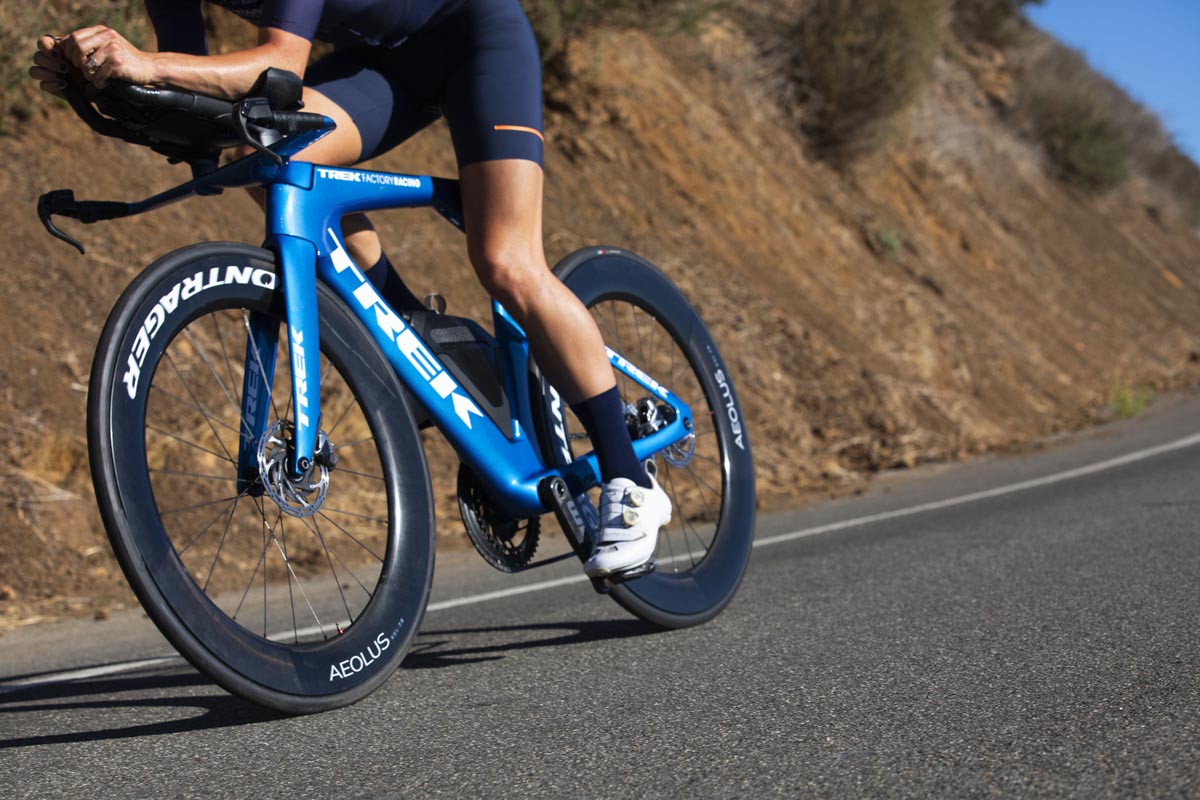
- Click to share on Facebook (Opens in new window)
- Click to share on X (Opens in new window)
- Click to email a link to a friend (Opens in new window)
It wouldn’t be a tri bike launch without claims of improved aerodynamics. Don’t worry, Trek assures us that the new Speed Concept certainly qualifies. In fact, they say it’s the fastest bike they’ve ever tested in a wind tunnel. But there are so many other things going on with the new frame that it’s almost easy to forget that this thing will apparently save you 6 minutes over a full Ironman-distance bike leg.
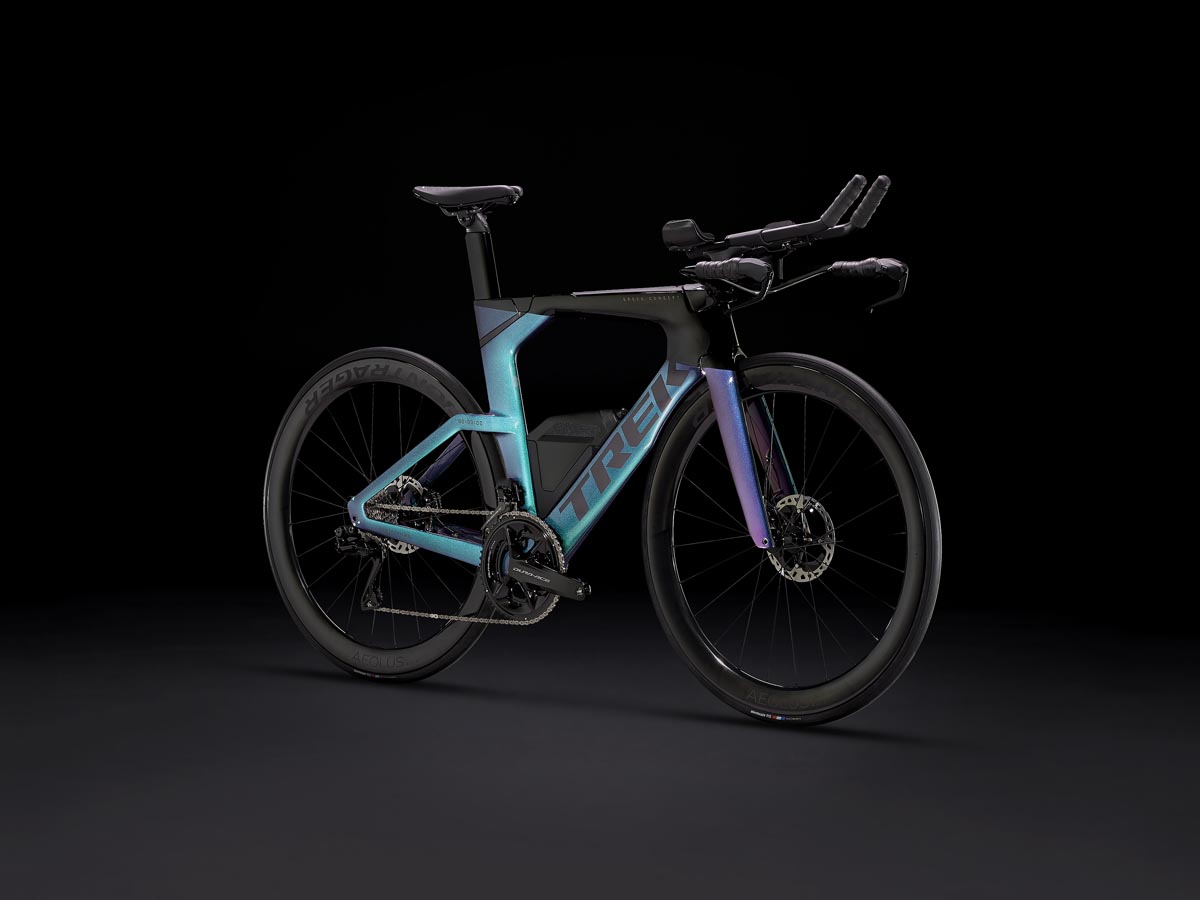
This is called the Speed Concept though, so we’ll start there. Thanks to the Trek Performance Research team and big investments like an on-premise supercomputer to run CFD simulations, Trek seems to have made big strides in terms of aerodynamics. The company claims that they run CFD simulations non-stop, which allows them to continually test for small improvements rather than having to pay someone else to run their simulations, which isn’t time or cost-effective.
The CFD testing eventually gives way to wind tunnel testing, and real-world aero testing, in which Trek discovered their new bike was 16w faster than the previous Speed Concept. That should be good for about 6 minutes based on a winning pace at Kona for a full Ironman distance bike leg.
IsoSpeed Comfort
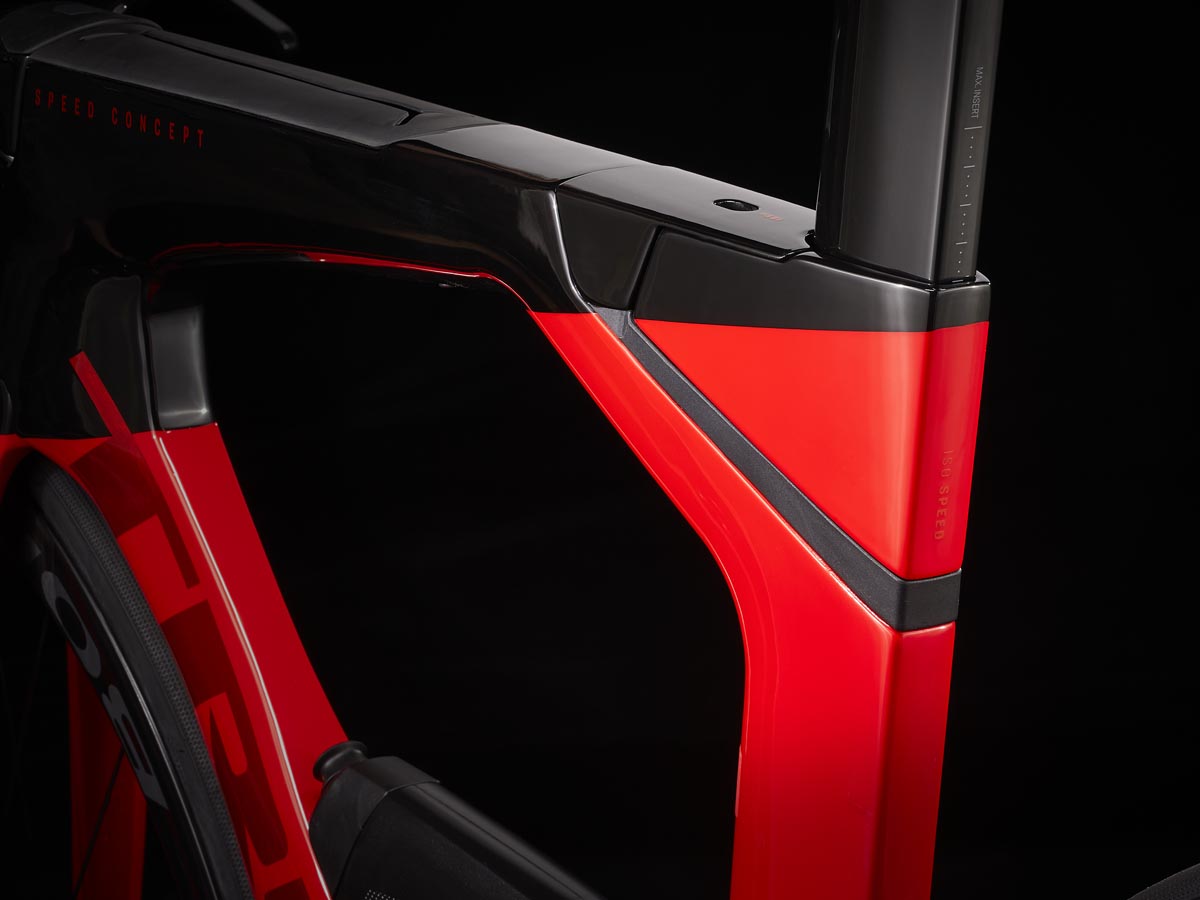
Aerodynamics are great, but not if you have to sacrifice comfort. Aerodynamic triathlon bike design often involves big sections of carbon fiber for the frame, deep-section wheels, aero seat posts—in a word, stiff. To give the Speed Concept a big leap forward in rider comfort, Trek added their proven IsoSpeed technology to the seat tube. This claims to have improved rider comfort by a whopping 30-40%. Trek says that the IsoSpeed pivot placement is farther forward to work better with the weight bias of most triathletes’ positions.
Incredibly (and easily) adjustable
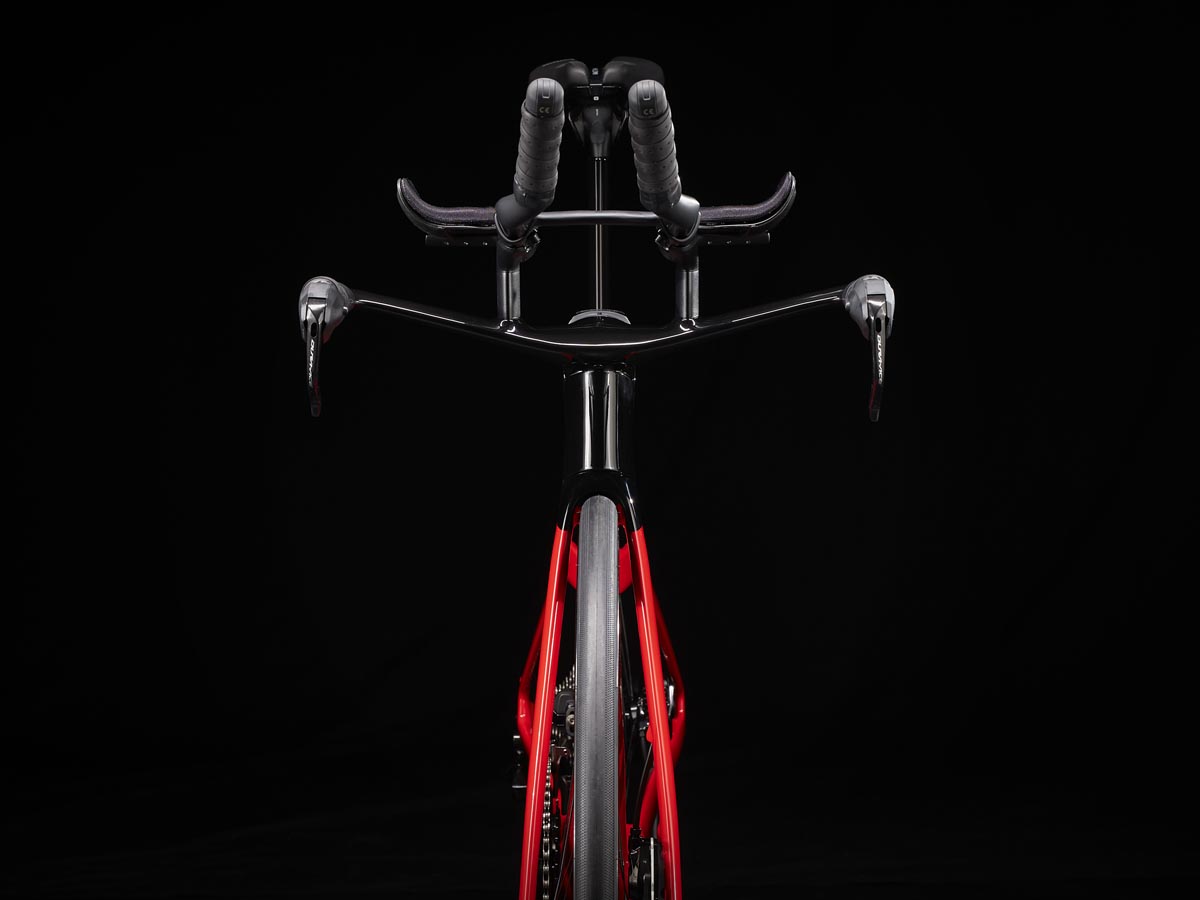
When it comes to comfort, fit is also incredibly important. So Trek created a brand new fit system to expand the fit window and make the bike easier to adjust and live with. There are three different base bars with 15mm differences in stack height and with different tower bases on top of that. Tower bases go from 0 to 75mm in 15mm increments plus there are 5mm adjustment spacers that can be put on top. The 5mm spacers have slots on the inside so you can add or remove them without re-cabling the bike. The stock extension and pad angle is set at 7°, but there is an angle adjustment spacer that can change that to 14° or 0°. That angle adjustment spacer also has a slot in it so you don’t have to recable.
In total, there is 0-115mm of pad stack adjustment, with up to 85mm of pad stack adjustment on a single base bar. In terms of pad reach, there are three different tower toppers, plus 60mm of adjustment from the extension base which results in 160mm of total reach adjustment. The length of the extensions is adjustable as well with three different mounting locations for extensions to the extension bases, which results in 100mm of total adjustment from the back of the pad to the end of the extension.
The pads also have about 120mm of total adjustment side to side, plus 10° of rotation adjustment. The reach adjustments are completely through the extensions, keeping the aerodynamics intact—moving from a monoriser to the new dual-tower design was a big part of the improvement in aerodynamics, which helps make the rider more aerodynamic by channeling the air around them.
Travel Friendly
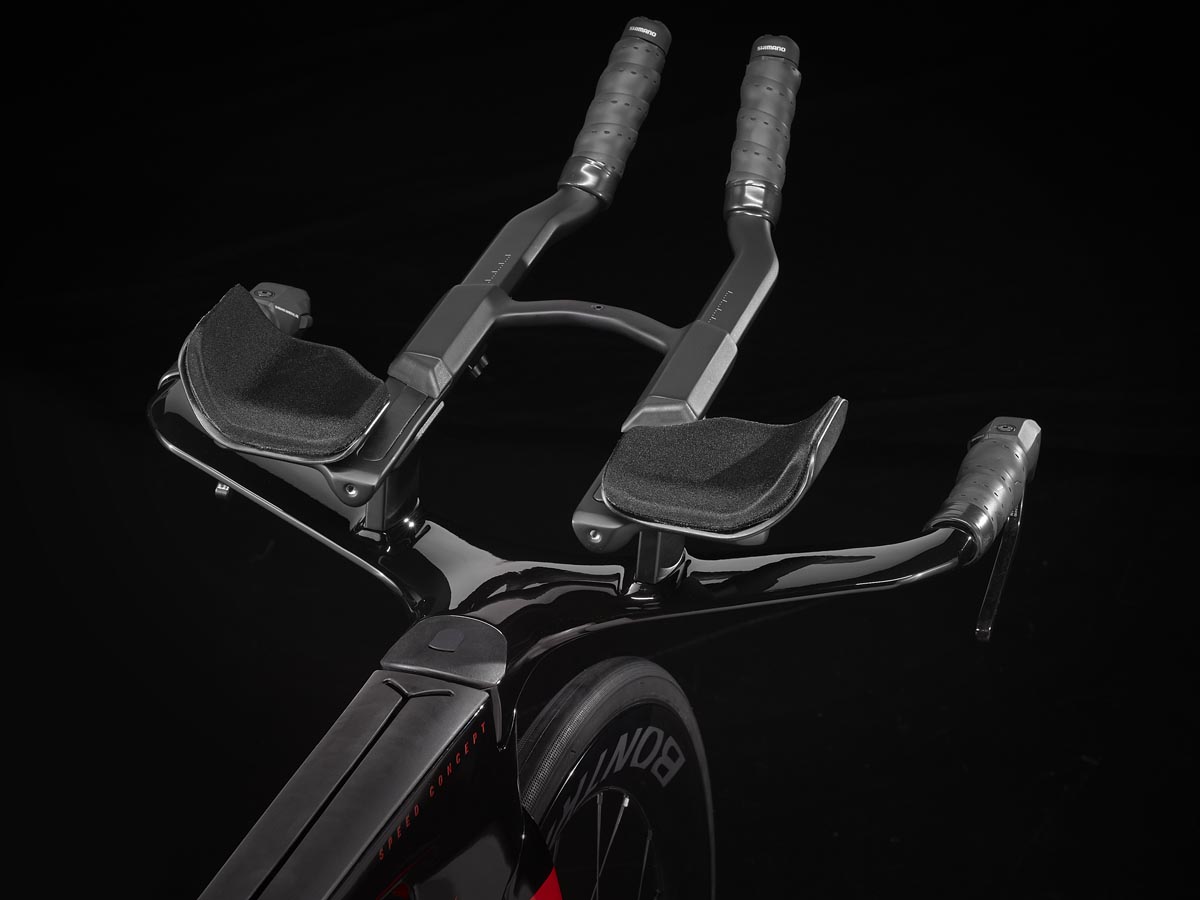
And since competing in a triathlon typically includes traveling, Trek has designed the new Speed Concept cockpit to be easily packed without affecting your fit. When traveling, you can simply pull off the base bar which preserves all of your adjustments. This is possible since the new bike uses a more traditional steerer tube arrangement instead of the integrated fork/headtube/stem on the previous bike. If your packaging requires it, the towers can also be removed using just four fasteners which also maintains your fit, just with a little more work.
What size should I get?
With all those fit options, not sure what parts you’ll need or what size? Fortunately, Trek created a fit calculator for that exact purpose. Just input your pad stack, pad reach, and your seat post height and the calculator will tell you the ideal combination of parts to start with.
Room for nutrition
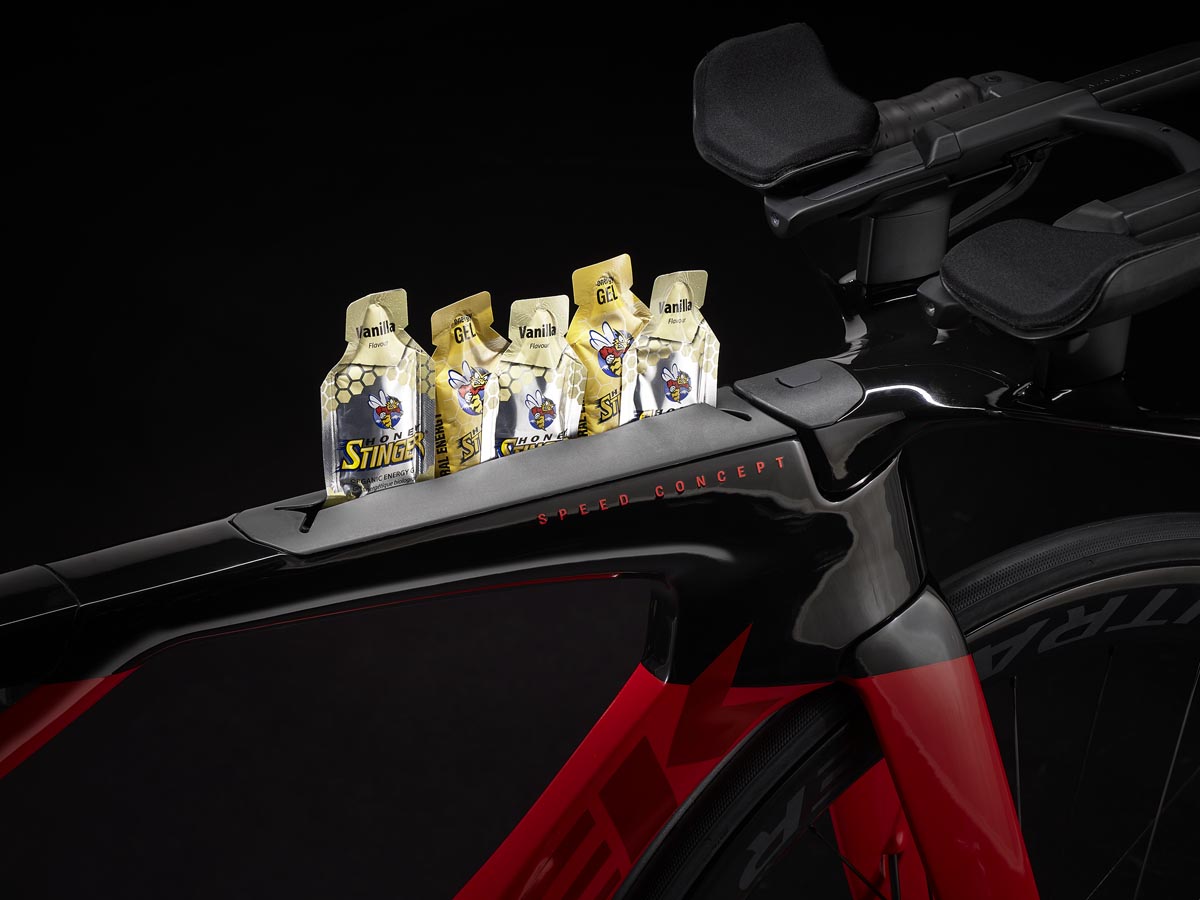
A big part of triathlon bike design is on-bike storage for nutrition, hydration, and tools. The new Speed Concept has you covered there too. For those gels, there is a removable Bento Box that’s built into the top tube instead of sitting on top. That allows you to stash the food inside without an aero penalty. But it’s also removable and dishwasher safe so you can easily hose out all the gunk after your bike leg. Included with the bike, the Bento Box can store up to eight gels.

Then there’s the Aero Downtube Bottle, which again can be used without any aero penalty. The 700ml bottle is included with the bike and clips into its own bottle cage.
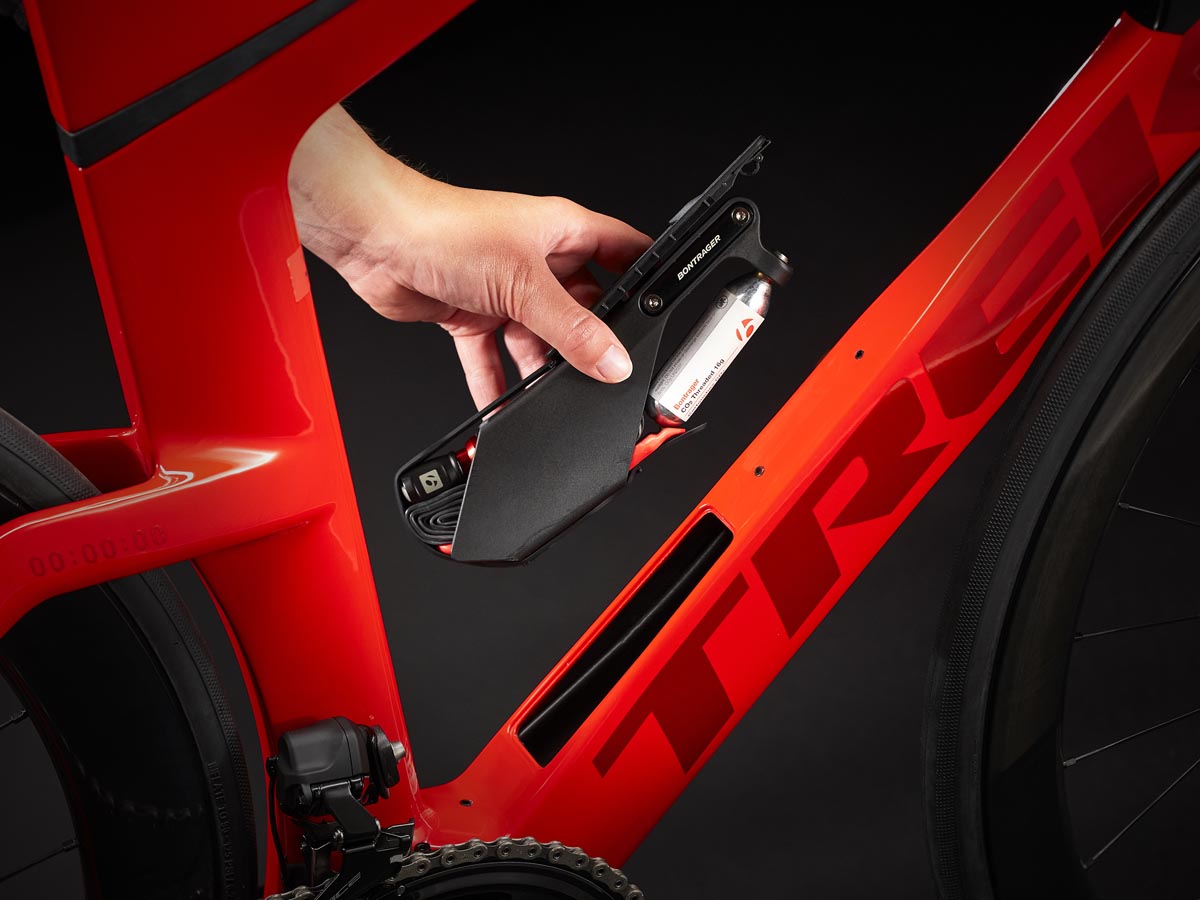
Which can easily be removed to find the Flat Kit hidden underneath, inside the frame. Another accessory without any aero penalty, the cradle is included with the bike and will hold a BITS multi-tool, threaded CO2, inflator head, tube, and tire lever (which aren’t included with the bike).
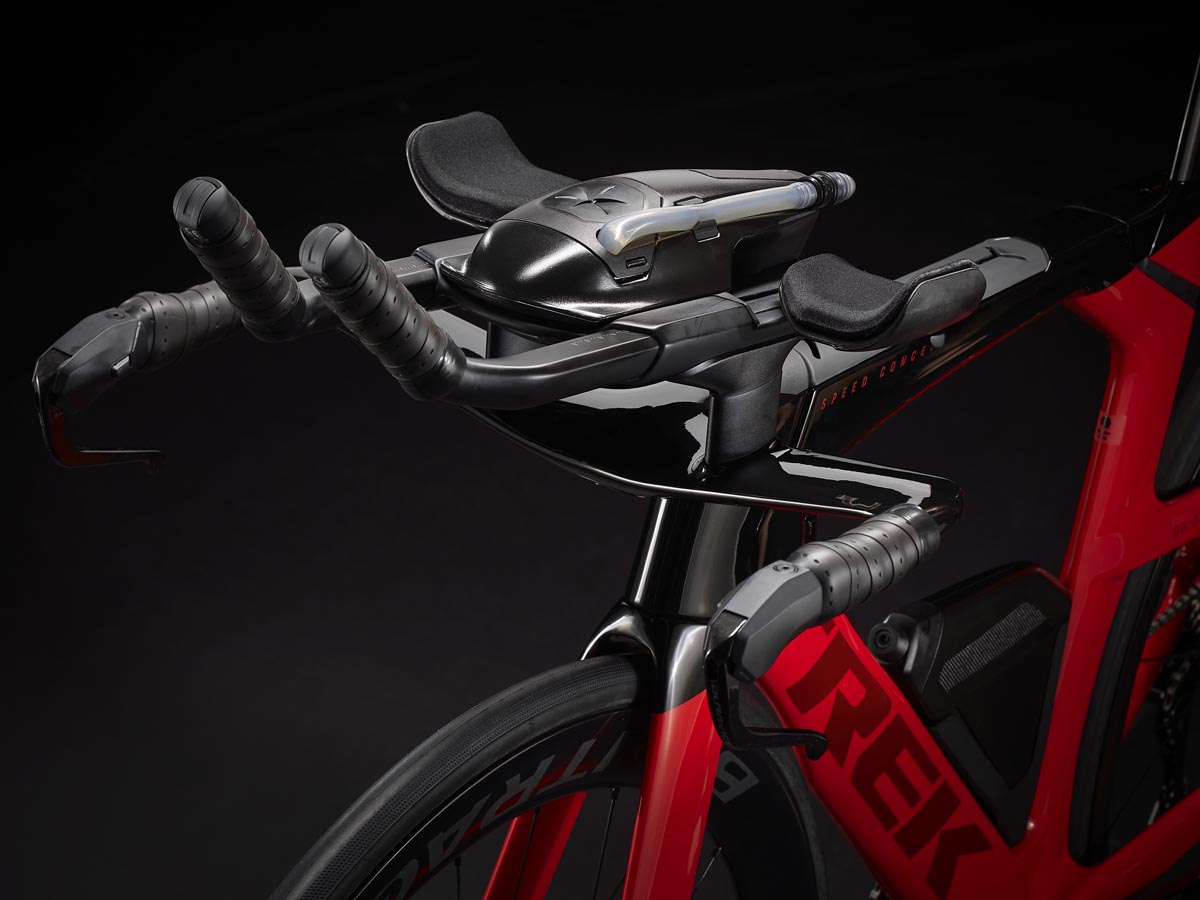
To finish the hydration system, Trek will offer the BTA aerobar bottle separately. This bottle also has a 700ml capacity and stores between the arms of the aerobars. There is a hose that is accessible without leaving the aero position, helping you fast and hydrated.
Better braking
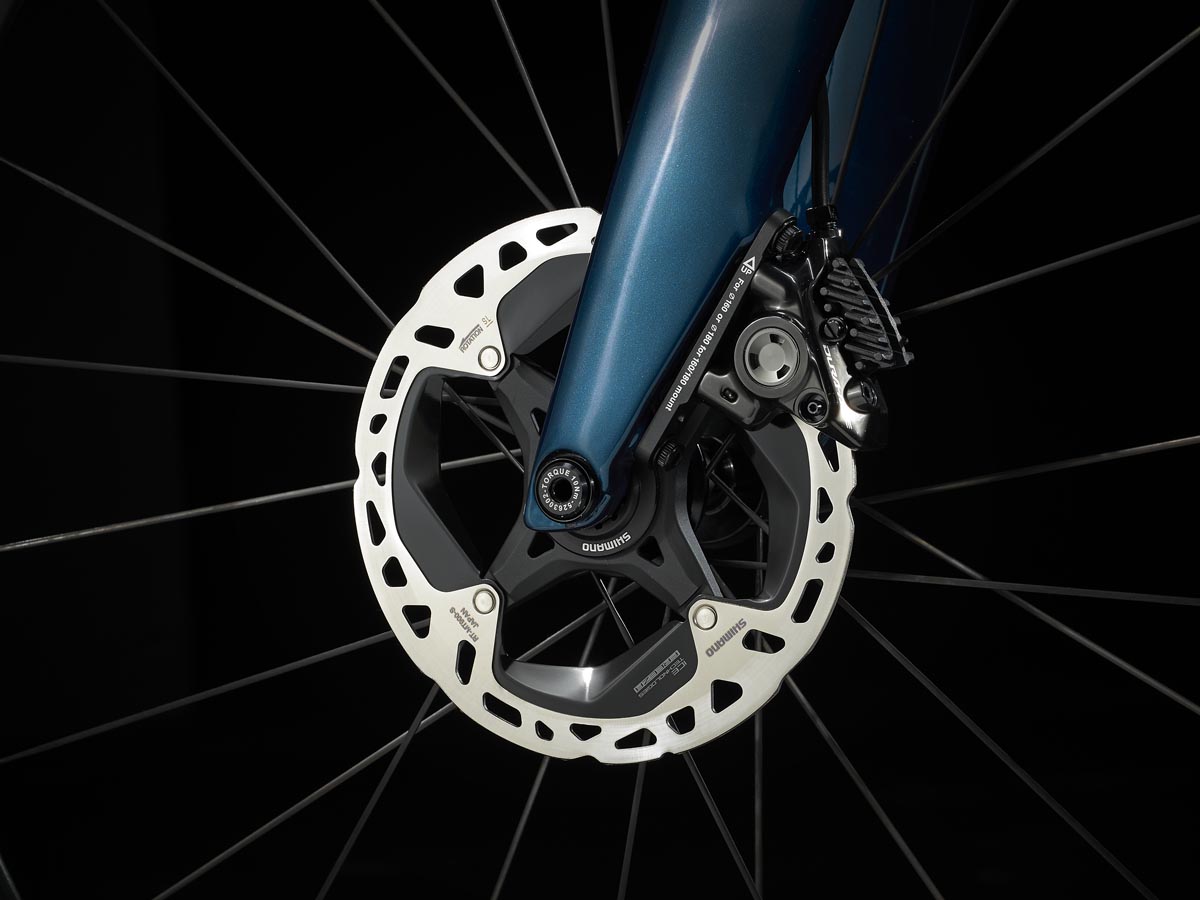
Finally, the frame makes the expected leap to disc brakes for better braking performance—but Trek’s aerodynamics team says that this also allowed them to engineer a faster bike. More importantly, even with the addition of disc brakes, a T47 bottom bracket, and all of the new features, the new frame is still weight-neutral compared to the previous version. Meaning, they didn’t add any weight to the frame, something Trek partially credits to the use of OCLV 800 carbon fiber.
TT Version + Pricing

Not into triathlons, just all-out speed? Ther is also a Speed Concept TT which is a stripped-down version of the bike specifically for time trials without IsoSpeed, storage solutions for nutrition and hydration, or the flat kit. The TT version also has slightly different geometry, and will only be offered in S-L frames, whereas the triathlon version is offered in S-XL. The TT version will be available to consumers, but only as a frameset for $4,999.99. You’ll also be able to buy the triathlon version of the Speed Concept frame for the same $4,999.99.
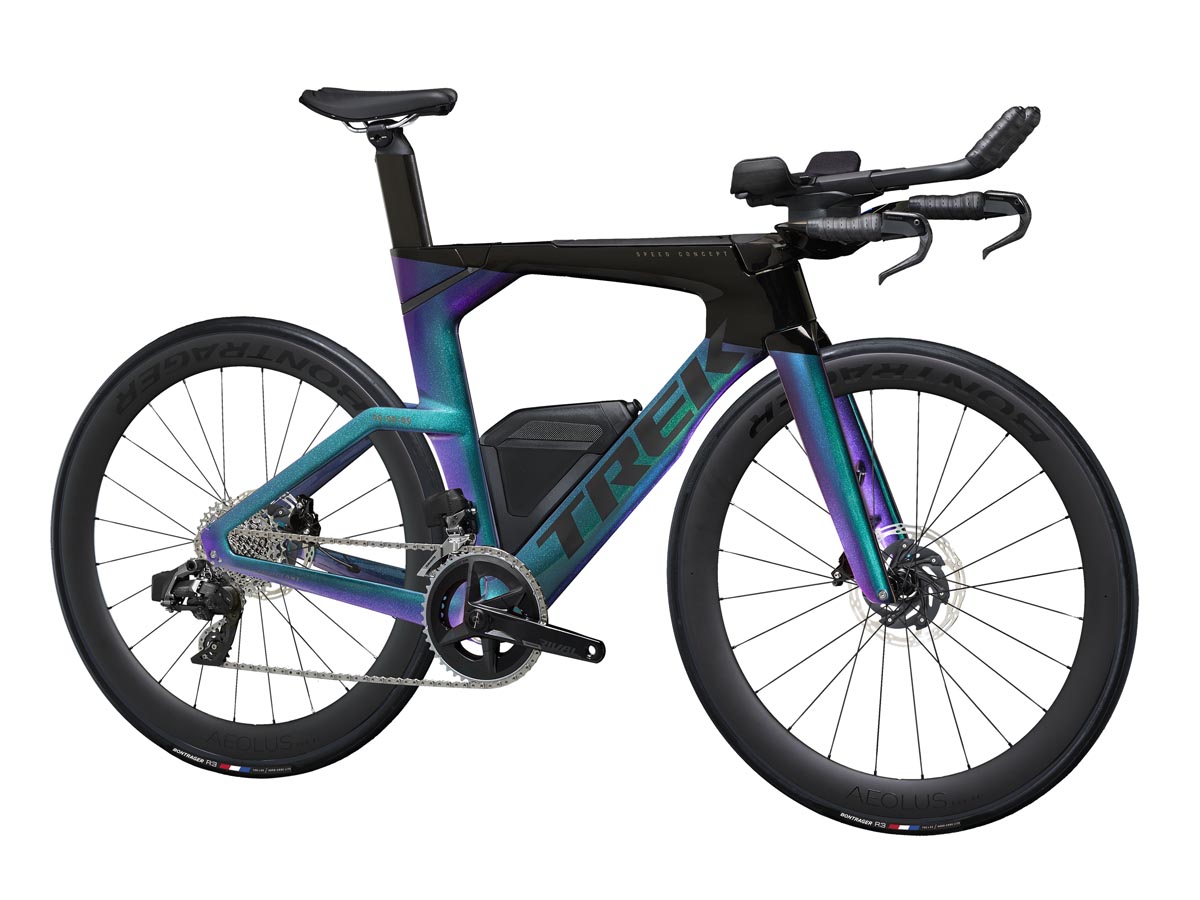
Only offered through Project One, Trek will offer the Speed Concept in both Shimano di2 and SRAM eTap versions and in SLR 6, SLR 7, and SLR 9 trim, ranging from $8,799.99 to $13,499.99.
trekbikes.com
Zach Overholt is the Editor in Chief of Bikerumor . He has been writing about what’s new in the bicycle world for 12+ years. Prior to that, Zach spent many years in the back of a bicycle shop building and repairing nearly every type of bike, while figuring out how to (occasionally) ride them.
Based in Ohio, Zach is now slowly introducing a new generation to cycling and still trying to figure out how to fit the most rides into a busy schedule as a new dad.
This site uses Akismet to reduce spam. Learn how your comment data is processed .
Rival. 8800$. Something went wrong.
I’d pay $8k for apex Etap,
My TT is fine and i won’t change it but i would absolutely go for the Rival one. I would not care the slightest that the jockey wheel bearing are ceramic. You get the top frameset and on a TT that’s 85% of your bike, also a fine wheelset.
Zach, can you find anything on tire clearance? Will a 28 fit? Doesn’t look like it has adjustable dropouts, correct? 28s and isospeed would really help on courses like Wisconsin…
From the trek website: https://www.trekbikes.com/us/en_US/us/en_US/bikes/road-bikes/triathlon-bikes/speed-concept/speed-concept-slr-9/p/35757/
Max tire size 28c rear, 25c front
Follow Us On
Subscribe Now
Sign up to receive BikeRumor content direct to your inbox.
Fast. Faster. Fastest ever. Introducing the third-generation Speed Concept Speed Concept is a triathlon bike engineered to be fastest in its class. But it’s not all aerodynamics and ultra-light carbon. It’s also seamlessly designed hydration and fueling systems that boost your energy post-swim, keep you strong as you cycle, and set you up for your best run ever. We put our best into this bike, and you’ve put your all into training. This is your year—go out and earn what’s yours.
Designed to make you faster than ever Six minutes. That’s how much faster this Speed Concept is on an Ironman course than previous models. When you’re racing to place, that’s a huge advantage. But these types of gains don’t come easy—it took years to hone the bike’s design to blazing fast perfection. After thousands of iterations and a handful of trips to the wind tunnel, we found every watt and ounce possible.
- Learn how we made it aero
Fast shapes, ultralight carbon
Drag-reducing Kammtail Virtual Foil tube shapes cut through the air, and ultra-light 800 Series OCLV Carbon allows us to craft these fast aero shapes without compromising on weight.
Redesigned aero frame
From the fork to the headtube and the seat stays, Speed Concept’s frame is meticulously engineered for aero gains and is 180 grams lighter than our previous chassis.
Disc brakes without the weight
Disc brakes deliver more stopping power than rim brakes in any conditions, but they can also add weight. By optimizing the design of the fork and the wheels, we only added 170 grams. Most disc brakes designs add 450 grams of weight!
Stay fueled, stay fast Carbon fiber and aero tube shapes aren’t the only factors that’ll make you faster. That’s why we put a ton of brainpower into creating the most aerodynamic and intuitive hydration and fueling systems for Speed Concept. You won’t miss out on free speed, and you’ll stay perfectly gassed up for your ride and run.
- Learn more about fuel and storage systems
A better between-the-arms bottle
Designed to boost aerodynamics and hydration. The built-in straw makes it easy to take a sip, and when you need a refill just grab a bottle from the station and squeeze it into the bottle via the silicone port.
Fully integrated bento box
Built directly into the top tube, you can hold a race’s worth of nutrition inside. Removable dividers let you keep things organized, and a stiff silicone top with a slot makes access easy without sacrificing aerodynamics.
Aero down tube bottle
Designed for drink mix concentrate so you can calibrate your nutrition perfectly. Just squeeze a bit into the BTA’s silicone port to get the right fuel ratio.
Hidden down tube storage
Under the down tube bottle there’s concealed storage that holds an entire flat kit! A CO2 cartridge, Bontrager BITS tool, and a tube can fit inside.
A more comfortable, compliant ride Most tri bikes are… wildly uncomfortable to say the least. Not this one, as it comes with road-smoothing IsoSpeed that’s 30% more compliant than before. Because triathletes naturally sit closer to the nose of the saddle, we did a lot of testing to figure out the best place to put IsoSpeed. The result is a new, tri-specific IsoSpeed with a pivot position that’s much farther forward than other road bikes. And if you’re wondering if a more comfortable ride translates to performance improvement—yes. In real world testing done by Trek’s Performance Research Lab we’ve found that a more compliant ride is less fatiguing for your body and helps keep you fresher for the run.
Dial in the perfect fit A great bike fit is absolutely critical for triathletes—you stay planted in your aero position for mile after mile. That’s why the new Speed Concept has a huge fit window and tons of opportunity for adjustment. You can customize every bit of the bars, extensions, towers, pads and more—and we’ve made it quicker and easier to adjust, too.
- Learn more about Speed Concept fit
Travel with ease Once you’ve got your perfect fit, it’s almost devastating to have to break down your bike for travel. Fear no more—we’ve made it incredibly easy to pop off the base bars and extensions, and your fit positions will be preserved perfectly for when you re-assemble your Speed Concept at your destination.
- Learn how to travel with Speed Concept
Speed Concept takes gold time and time again
The newest gen Speed Concept has won multiple UCI time trial world championships, Ironman world championships, and more. Learn more about Speed Concept’s victories across the globe.
UCI World Hour Record
Ellen van Dijk set the fastest UCI World Hour Record on her fully-custom Speed Concept. She smashed the previous record by a full minute.
Exclusively available in Project One The all-new Speed Concept is available only through Project One, giving you the chance to create your ultimate custom tri bike. You can customize every bit of the fit, the components, and of course, the paint.
- Customize your Speed Concept
Explore the Speed Concept family
Learn more about Speed Concept
Aerodynamics
Learn how we made Speed Concept so fast.
Fit and travel
Learn how to dial in your fit and how to travel with Speed Concept.
Storage systems
Learn how Speed Concept helps you stay hydrated and fueled.

- Life of Tri Podcast
- Personalities

Bike Review: Trek Speed Concept SLR7
Trek's revamp to its speed concept tri bike was worth the long wait.
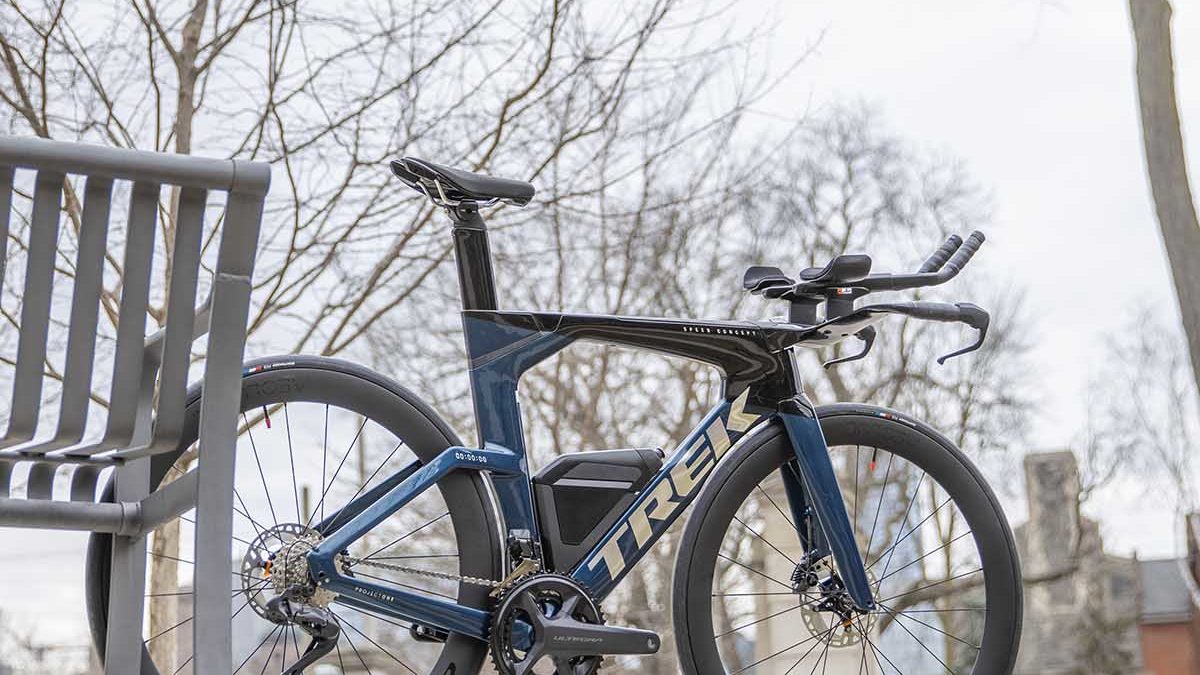
There were seven years between updates on Trek’s triathlon/ TT bike, but when the company launched the redesign of the Speed Concept last fall, it announced some impressive numbers. According to Trek, the new version is six-minutes faster over a full-distance, 180-km bike course. And that speed isn’t just for pros and Uber-biking age-groupers – Trek says there’s even more gains for athletes who are averaging slower speeds for their long-distance efforts.
We didn’t take the bike into a wind tunnel to check their numbers, but we can tell you that this is a bike that wants to go fast. Trek’s excellent fit calculator helps you dial in the correct size frame and all the components to nail your set up, and the new integrated front end is both extremely aero and comfortable, so you’ll have no problems staying down in an aero tuck for even the longest efforts.
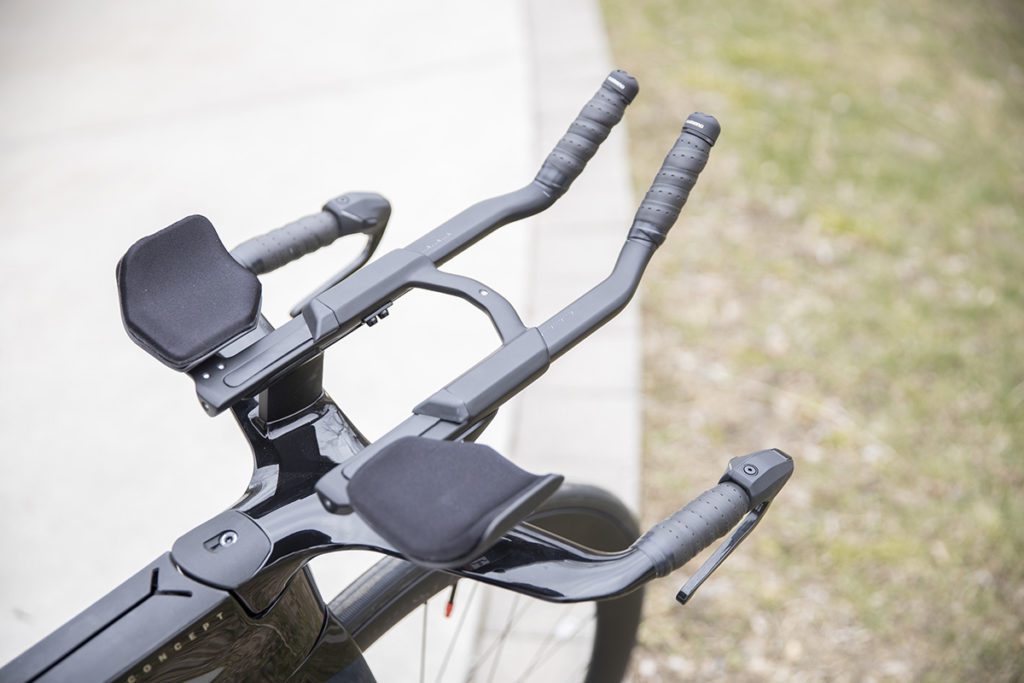
Adding to the comfort factor is Trek’s IsoSpeed design – basically the seat tube is decoupled from the top tube and flexes as you go over uneven roads. This results in one of the most comfortable rides we’ve ever had on a tri bike.
That comfort doesn’t sacrifice performance at all. While this isn’t a bike that is designed for big climbs, hitting the steepest climbs in our area has always been our “go to” test for lateral stiffness. Its impressive how stiff this bike is where you want it. While you could easily see the Speed Concept excel on a tough climbing course like Lanzarote or Nice, what this means for most users is that all the power they put into the pedals will move them forward. Pounding away on a long, flat stretch of road in the aero position is a riot – did we mention this is a bike that wants to go fast?
Like pretty much every new bike we’re seeing these days the new Speed Concept comes with disc brakes for excellent stopping power and modulation. The Trek engineers have managed to incorporate the new brakes without adding any weight to the overall package and improving aerodynamics, too.
[shareprints gallery_id=”71953″ gallery_type=”squares” gallery_position=”pos_center” gallery_width=”width_100″ image_size=”small” image_padding=”0″ theme=”dark” image_hover=”false” lightbox_type=”slide” titles=”true” captions=”true” descriptions=”true” comments=”true” sharing=”true”]
The SLR 7 model we reviewed comes with Ultegra Di2 components, the impressive Speed Concept integrated cockpit and Bontrager Aeolus Pro 51 tubeless ready wheels. (Click on the images above for more detail.) We did feel a bit of a push at the front end in strong side winds, so if you’re lighter and heading to a race like Kona or Lanzarote, you might want to consider a shallower front wheel, but for most people the Aeolus Pro 51s are an excellent choice.
In terms of storage, the Speed Concept allows you to carry your hydration and nutrition supplies without any aerodynamic penalty. The included downtube bottle holds 750 ml of liquid, and Trek also sells a BTA (between the arms) water bottle – both improve aerodynamics. There’s an integrated Bento box, too, with movable dividers that can hold up to eight gels. There’s a hidden storage area for a flat kit under the downtube bottle.
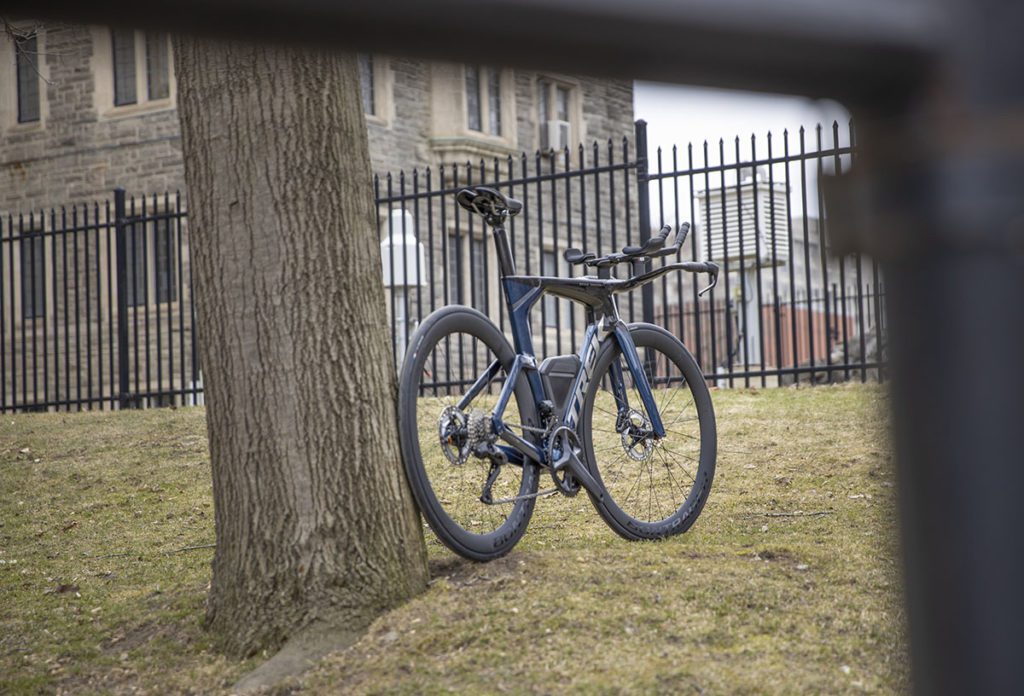
This is a race-ready package, but since the new Speed Concept is available through Trek’s Project One program, you can customize everything from paint to components for the bike. There are three base bar options and three stack tower possibilities, so you can really dial in the perfect fit.
It might have been a long wait, but Trek has done a great job with its latest triathlon-specific bike. Based on the pricing, Trek is definitely focussed on the high-end consumer with the Speed Concept, but you get a lot of speed and performance for all that money you’ll spend.
- Email address: *
- Email This field is for validation purposes and should be left unchanged.

- Name This field is for validation purposes and should be left unchanged.
Looking for ways to manage pre-race nerves? Ask Scout, our new AI chat.
NEW! YOUR LOCAL RUNNING DROP
Get after it with nearby recommendations just for you.
Powered by Outside
Trek Speed Concept SLR 7 Extended Review
Trek’s third generation speed concept tri bike has sleek lines, tons of storage, a low weight, and suspension. yes, suspension..

- Share on Facebook
- Share on Reddit
Review Rating
19 pounds, 12 ounces.
New perk! Get after it with local recommendations just for you. Discover nearby events, routes out your door, and hidden gems when you >","name":"in-content-cta","type":"link"}}'>sign up for the Local Running Drop .
It’s been a while since Trek released their last version of the well-loved Speed Concept tri/TT bike. By my count, something like eight years since a serious revision—but maybe even more depending on your definition of “serious revision.” We’ve seen hints and glimpses and weird theories about the third generation Speed Concept (based on spy photos, we dubbed it the Speed Cncpt at one point). Visually, the new Speed Concept isn’t jarringly different than the last model, but there’s a lot more to this version than meets the eye.
Trek Speed Concept Gen 3: The Basics
Though we tested the SLR 7 Ultegra 12-speed build of this new Gen 3 Speed Concept, the features on each of the four flavors (SLR 9, 9 eTap, 7eTap, and 7) are similar—save for wheels, drivetrain, and a few other bits like saddles. The frames/forks/bars are the same. According to Trek, the big news about this redesign is the fact that the new version is six minutes or 16 watts at 26mph (roughly Kona-winning pace) faster than the previous version. But there’s way more to it than that.
First, this is Trek’s first Speed Concept with disc brakes—a trend that is unavoidable in today’s high-end road bike market. For years Trek fans were left behind when it came to a tri bike that would take advantage of the super wide rims, greater selection, and the even lower prices that disc-brake wheels brought. Finally, you don’t have to choose Trek or disc.
Next, we’re seeing a big redesign on the Trek’s front end. Notably Trek has ditched the monopost riser that ironically a few competing brands have recently adopted ( Orbea , for instance) and swapped it out for a dual-riser system with a very clean-looking—but also more flexible—fork/stem interface. No more cone/bayonet/brake cowl situation.
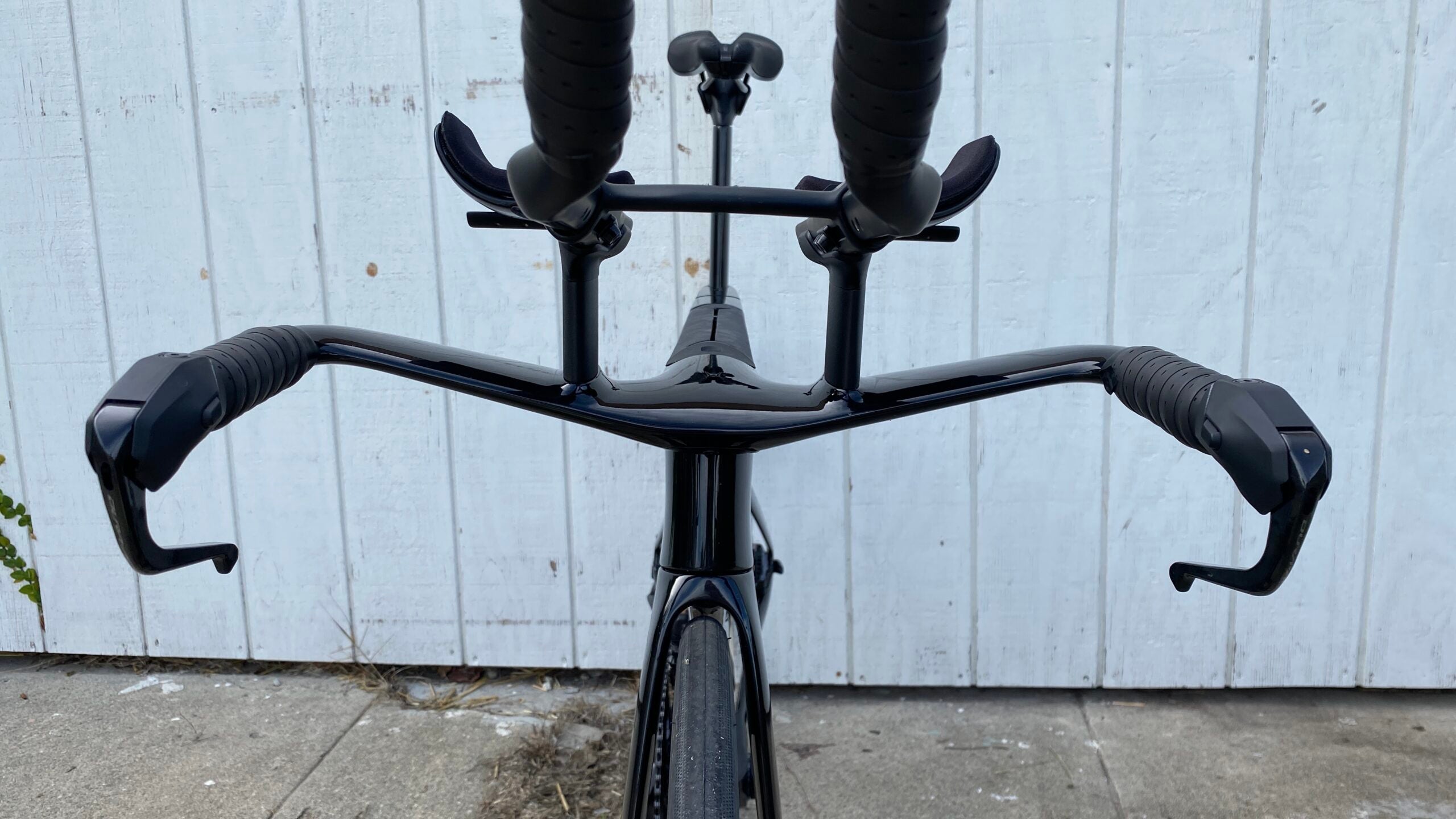
And while we’ll dig into the features in more detail just below, it’s worth noting that while Trek is playing catch-up with some of their features, they’re forging a new path with their IsoSpeed suspension system. While beam bikes can rightfully claim a level of suspension in their designs, IsoSpeed—which Trek has offered for years on other lines—is the first built-in suspension in a traditional double-diamond frame. The idea being that the suspension will lessen vibration from the road into the rider without sacrificing handling or stand-up response. Less vibration means less fatigue, which not only helps on the bike, but sometimes even more so on the run.

Trek Speed Concept Gen 3: The Features
There’s a lot going on with the new generation of Speed Concepts, so we’re going to break down the features on this bike below—in order from most effective to least—but leave our impressions until the following section.
Our size medium SLR 7 with Ultegra and midrange Bontrager carbon wheels weighed in just under the all-important 20-pound mark. While many triathletes might rightfully say that weight doesn’t matter much on a tri bike, there’s something to be said for how efficient this design is, and if the wind tunnel numbers are right, Trek did a great job of playing by the UCI rules, making things increasingly more aero, making a shockingly responsive ride, and doing it all without excess materials ( Scott Plasma 6 , I’m looking at you…). This is a tight bike with a low weight that comes as a result.
Aerodynamics
Trek claims this cuts 16 minutes off an Ironman time or saves 16 watts at 26mph. While most triathletes aren’t averaging 26mph for 112 miles (in fact, almost none are…), improvements are improvements. I’d love to see this setup against other bikes in this weight class like the new Quintana Roo V-PR , Scott Plasma 6, Orbea Ordu, or everyone’s favorite double-diamond benchmark, the Cervelo P5.
Disc Brakes
While it’s hard to argue that increased stopping power isn’t a good thing, there’s a lot more to the addition of disc brakes than that. Finally Speed Concept owners can use a greater selection of wider, faster, and oftentimes cheaper disc wheels. They also don’t have to deal with insane brake calipers and aero cowlings. In the latest Speed Concept, Trek also said it’s added discs without adding weight (a tough thing to do).
Hydration, Storage
Though Trek still hasn’t cracked the code on fully frame-integrated hydration like Scott or Canyon, their downtube hydration system is sleek and basically useful.
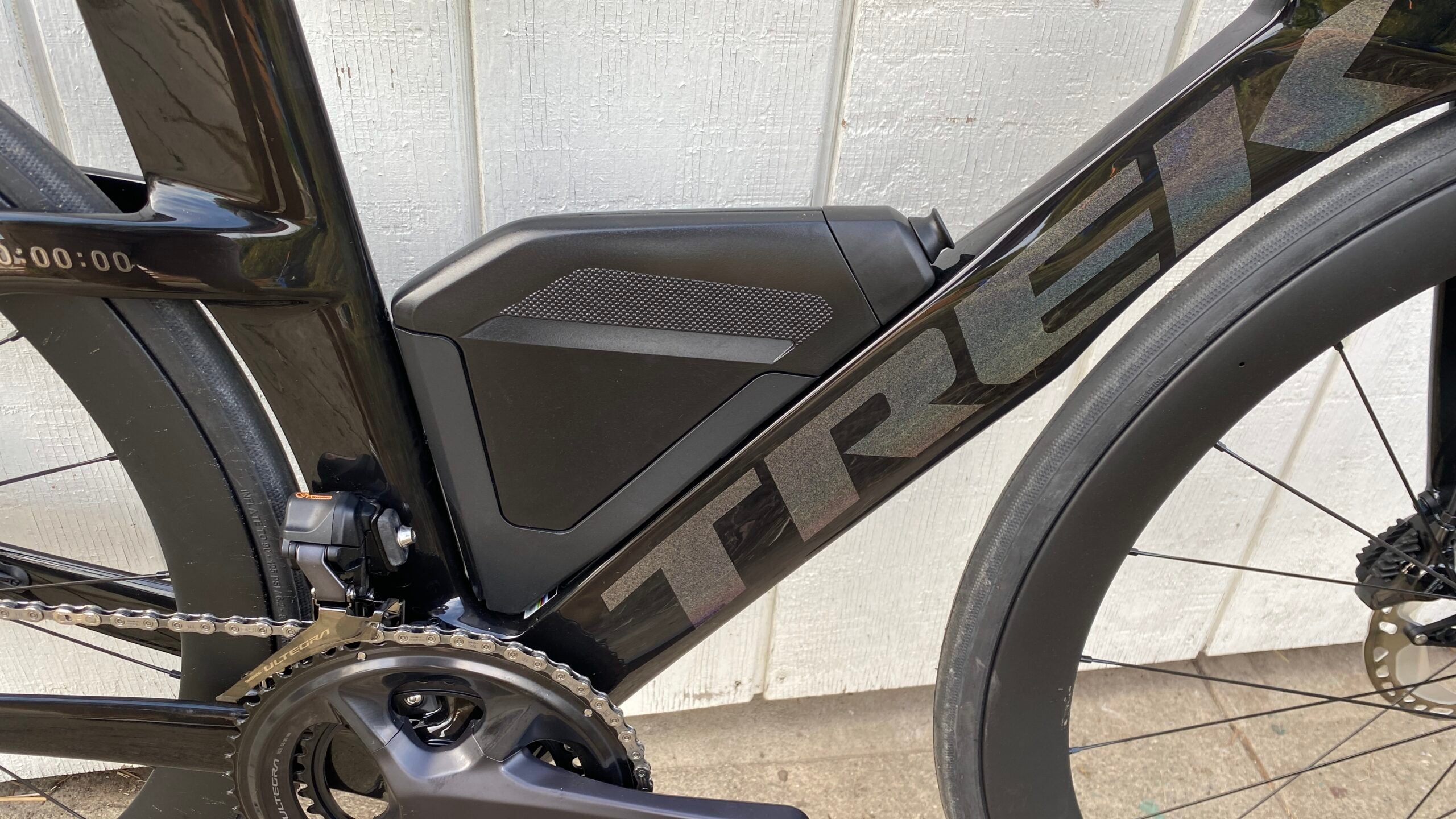
Their attachable between-the-bars system also looks about par for the course (we weren’t able to try it, however), and the integrated top tube storage actually went above and beyond what you normally see from a built-in bento box. (Removable dividers for organization helped manage the spacious cavity.)

Finally, we really really liked the built-in tool/flat storage that was tucked neatly beneath the downtube water bottle—in many ways it kind of looked like something Canyon would do.
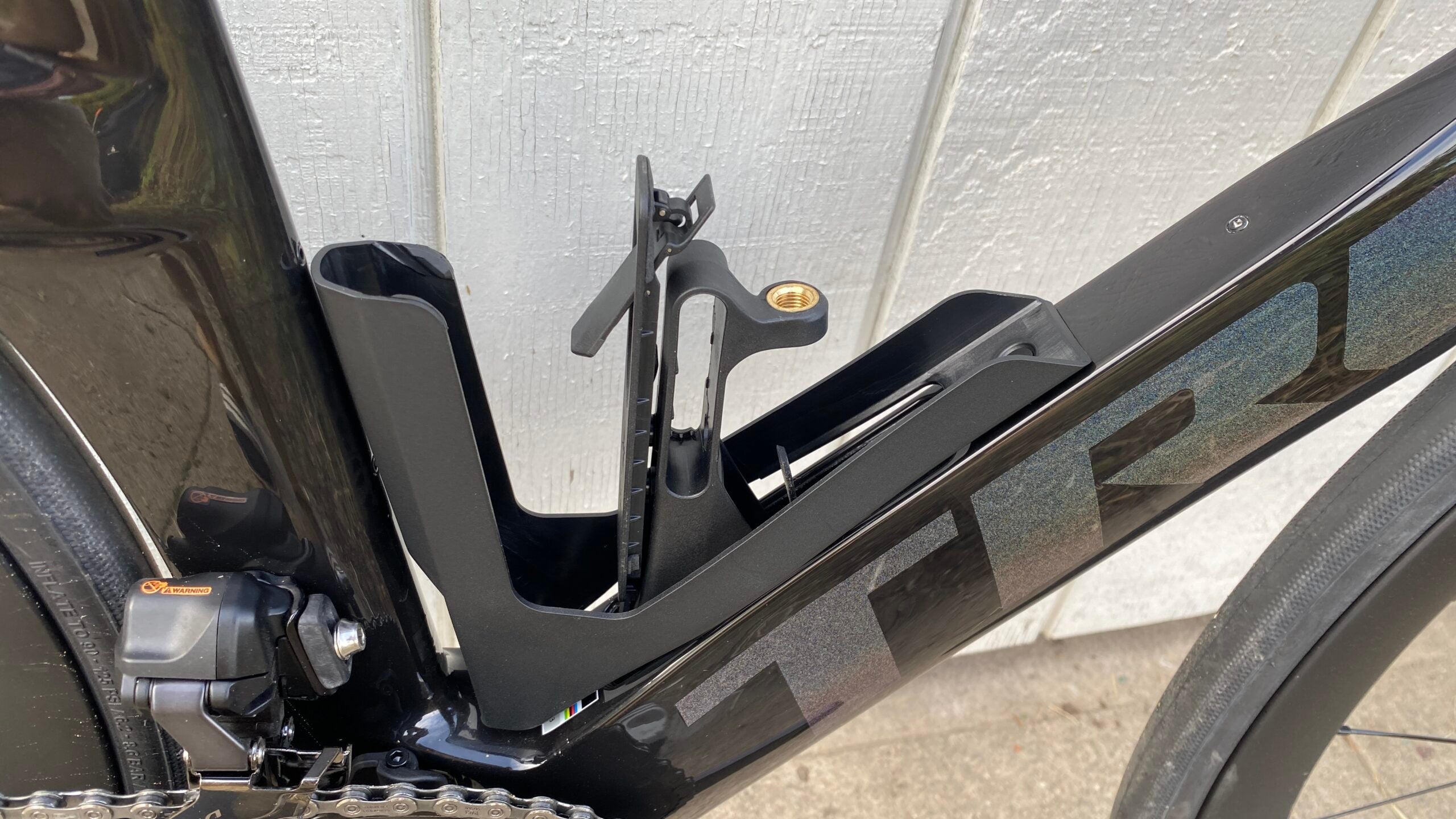
Suspension System
Trek’s IsoSpeed suspension system helps reduce vibration heading up from the road into the rider. Trek claims it increases compliance by 30%—which seems like a lot—by using an internal pivot system specifically placed to help with nose-riding triathletes. With reduced vibration, triathletes will have more energy to ride and run (especially if using a disc or deep-dish set of wheels). In practice, results were a bit of a mixed bag—hence this feature’s ranking on the list of features. Read on for our impressions.
Trek Speed Concept Gen 3: The Good
Oddly enough, there’s a lot that’s really exciting on this bike that Trek chose not to highlight for some reason. There’s a lot of talk about the increased aerodynamics (which are great, but hardly perceptible when riding under 26mph not in a wind tunnel) and the suspension system, but not a lot of mention about the way the bike handles, its road feel, its handling, or its weight (which is quite low for tri standards). Trek does highlight excellent storage—which the Speed Concept does very elegantly—and their wide range of easily adjustable fit options across four sizes. Those are highlights worth noting because the new Speed Concept is worthy of praise in those arenas for sure.

But the most interesting things we found while riding the new Speed Concept are slightly more imperceptible and in many ways rarer than things like storage and fit options. Not since Cervelo’s new P5—a bike that many brands flat-out use as a benchmark to compare their latest bikes to—have we had such a snappy, lively, and intuitive-handling bike. We’ll get to the vibration damping on this bike below, but the Speed Concept has a high level of road feel, accelerates quickly when standing or powering over rollers in the aerobars, and cuts corners very very well. Much like the similarly UCI-legal P5. Because the design is tight and well-thought-out, the Speed Concept feels completely connected to the rider—right out of the box. While it might not hold straight lines like the new V-PR in a screaming downhill aero tuck, it moves aggressively around obstacles and corners without earning the “twitchy” label.
Also much like the P5, the Speed Concept travels very well, as you only need to loosen a few bolts to bring the front end off and pack it up. All compartments and coverings are similarly well-integrated without a bevy of tiny bolts to potentially strip and/or get lost. Here, Trek clearly spent a lot of time in their design iterations to make sure things on the user side were simple, all while giving plenty of features that triathletes expect from a near-$10k bike.
Trek Speed Concept Gen 3: The OK
There are a few little nit-picky things on the Speed Concept that you only typically bring up if the rest of the bike is really really good. So we’ll start there. First, the saddle that comes with the SLR 7 version is shockingly hard and shockingly wide. This might work for some triathletes, but others will likely need an immediate swap.
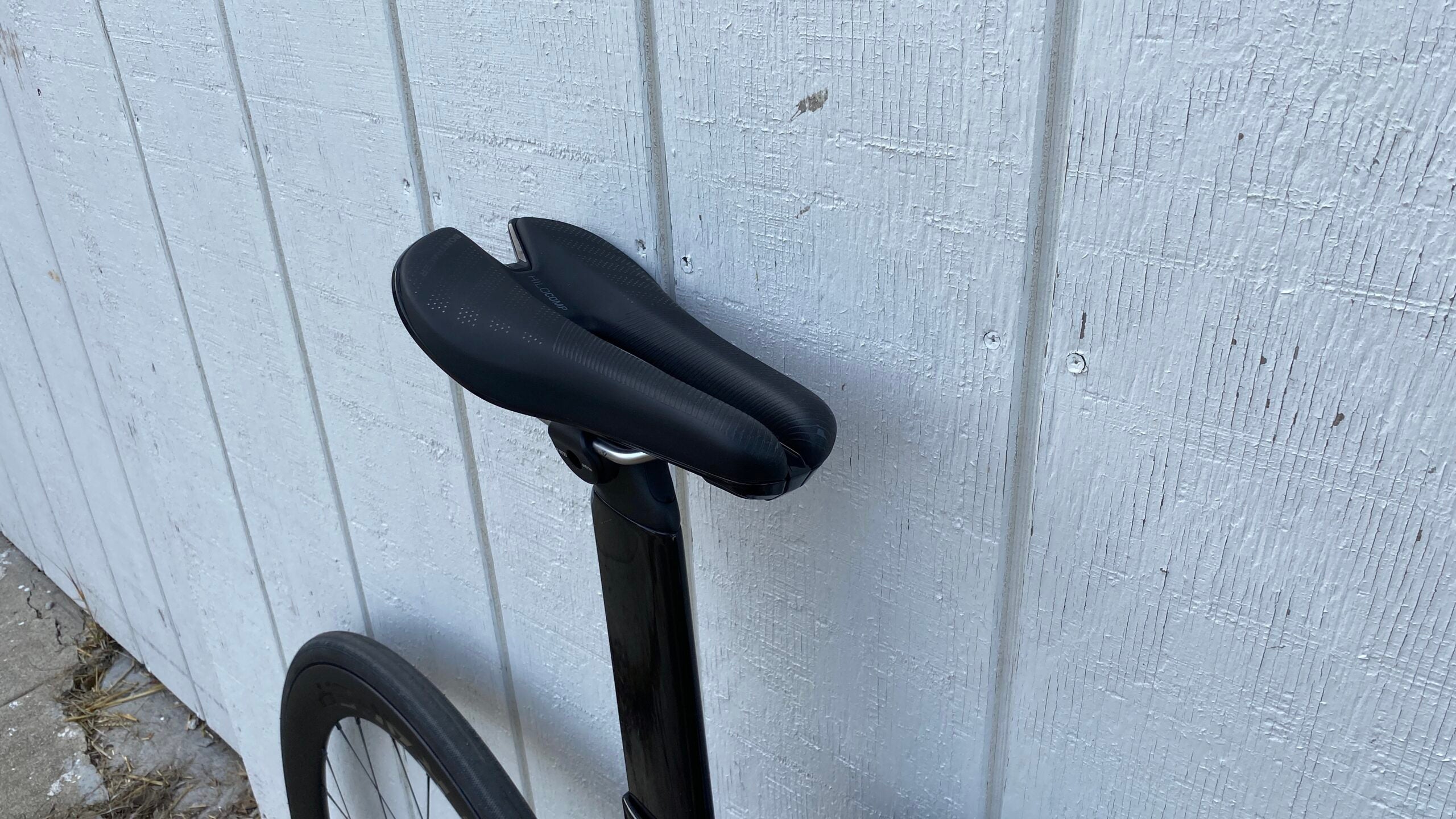
Next, while there is a lot of fit flexibility in the four sizes that Trek offers, the seat angle can’t get as steep as some triathletes might want (if so, look to Canyon or Quintana Roo to get really steep). Also, like many (but not all) integrated front ends that are super cool, you can’t change out the aerobar extensions for a different style without changing the whole bar system—the Speed Concept’s unusual (but easily adjustable) aerobar shape ensures this. Finally, in the nit-picky section, we were surprised that Trek sold this with midrange 51mm carbon wheels on the front and rear. I would hope to either knock $1K off the price and go with basic trainers or add a few bucks and give this rig a proper deep rear/mid-depth front.
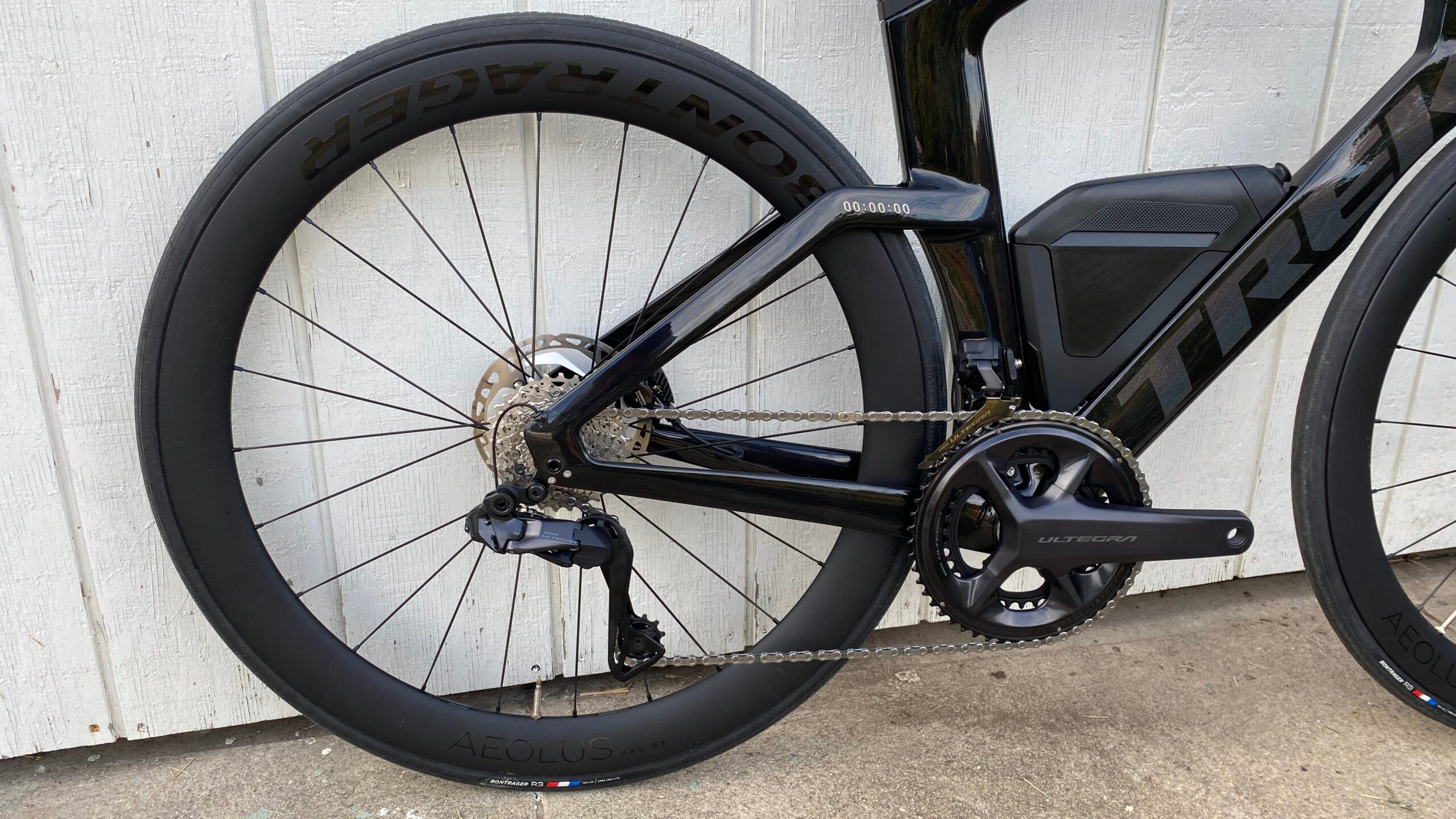
The last thing we were surprised by was how not-smooth the ride was over low- and mid-frequency road vibrations. Given that Trek probably put a lot of time and effort into their IsoSpeed system—which worked like a charm over high-frequency road chatter—the ride was much rougher than I would have thought. That’s not to say the new Speed Concept is a rough-riding bike in the grand scheme of things, but there are at least three other new bikes off the top of my head with a smoother ride at this price range and no suspension system. Of course none of those bikes have the handling and acceleration of the Speed Concept either—so there’s a give and take, of course.
Trek Speed Concept Gen 3: Conclusions
I wasn’t sure what to expect when I first got on top of this new Speed Concept. I had always liked the old version in the way that it was predictable but unremarkable. It wasn’t a bike that would get you excited to go out and ride, but it also did it’s job just fine. The third generation of this bike seems to have gotten the “excitement” variable right. This is a fun bike. Sure it’s not as tri-specific as some of the other brands we’ve mentioned here—ones with in-frame hydration and all sorts of other non-UCI-legal goodies—but there’s something to be said for a simple, no-frills design with key features that works very very well.
I think this is (finally) a very big upgrade to the Speed Concept line that might serve as a marker to other brands for a new benchmark. For years, I’ve even used the P5 as something to measure other tri bikes against—particularly when it comes to weight, handling, and acceleration (because of course I don’t have a wind tunnel). This could replace that. I like how easy it is to work on this bike, travel with it, and adjust it. I like the way this bike feels when I ride it, and I know everything on it will stay on it and stay quiet as I add more miles onto its odometer. Not every bike at this price can say that, and with the latest version of the Speed Concept, Trek has made some big, necessary, and exciting improvements that’ll stick for years and years, until the next update.
Popular on Triathlete

Join Outside+ to get access to exclusive content, 1,000s of training plans, and more.
© 2024 Outside Interactive, Inc
Bike Rebel Without a Cause
Cyclopaat, an alter ego with a twist
Trek Speed Concept Review

I’ve been riding my Trek Speed Concept SLR 9 for a few months now since it was deliverd in February.
That is, because of the lousy weather and me not wanting it to get dirty on its maiden voyage, I didn’t actually ride on it before early March 😂
But since then, I’ve already taken it out for a spin more often than I ‘promised’ Paula – and myself, sorta – when I got it…
While I first blamed that on me having to fine-tune my Speed Concept, then practise a bit on it before the Tijdrit Almere , I have no other justification for that, other than that it’s so much ‘fun’ to ride it.
Well, not during the much anticipated ITT, as that was over before I was able to drop the hammer on my PR…
And ‘fun’ should not be taken literally, as riding in the time trial position is never much fun and takes getting used to.
So, if you’re new to time trialling or triathlons, don’t expect this fantastic beast to make that any easier.
But, you will probably go faster – apparently, the claimed improvements actually get better if you’re not world class and cannot ride an ITT at 50 kph.
If you’re on a budget, you might just as well go for the ‘cheaper’ Sram Rival AXS version of the Speed Concept, which basically gives you the same components, other than the group set.
Even that will set you back €9.600, so don’t overestimate cheap – the cheapest Shimano (Ultegra Di2) is roughly €600 less…
If you are a Tri-athlete, Trek’s IsoSpeed system , meaning top and seat tubes are further out to match a triathlete’s more aggressive position, is a huge 30% more compliant, which should leave you less fatigued for the run.
I’ll take their word for it…
Mounting an ITT/triathlon bike for the first time can be daunting, but as I’m already used to that, I didn’t have any problems.
On the contrary: the Speed Concept is a lot less ‘ twitchy’ than the SpeedMax . I only had to make adjustments to fine-tune my position, i.e. pad width, extension length and the (stack)height between base bars and extensions.
If you’re not (yet) used to hydraulic disc brakes, the superior braking power of these will also boost your confidence.
I fitted my bike with Look Keo Blade Ceramic Ti pedals, which are a huge upgrade from the Favero Assioma pedals I had on the SpeedMax.
Not because the Assioma’s are not worth every penny, but if you want as little power loss on every stroke as possible, the Keo’s are far superior.
And looking at my power numbers over the past months, I consistently need to push less power to reach the same speed(s).
Some of the difference can be explained by the numbers from the Assioma’s being different from those I get from the Quarq chain ring PM, but they are equally accurate.
Which means it comes down to the superior aerodynamics of the Speed Concept, and the pedals.
At any rate, this doesn’t mean that I will go a lot faster, though.
In my experience, not backed by science, I need to push 10 to 15 Watts more for a mere 1 kph increase.
As my rides are more influenced by wind speeds than anything else, I should look at the long term average and that confirms I do need to generate less power than before…
One thing I’m always a bit weary about is the saddle, or rather: a saddle change.
However, the Bontrager Hilo saddle is almost comfy so I was very happy I could stick with that.
One upgrade I passed on was for the wheels: the Aeolus RSL 51 set has a lower rim than I was used to, but I will – probably – never go for closed wheels and the 58/82 mm rims on the SpeedMax were not very practical riding with tubes.
Which looks like no issue if you ride tubeless, until you get a flat in the middle of nowhere and need to put a tube in to be able to get home…
I did get the extra between-the-arms bottle on my Speed Concept, as that can be refilled from the (standard) down-tube bottle. However, I replaced both with ‘standard’ bottle cages within a week.
The ‘hidden’ down-tube storage is rather useless if you ever need anything from it fast, like during a race. It fits a tube, CO2 cartridge and multi-tool, but it’s a tight fit and I would prefer something that doesn’t require the removal of other parts to access.
The Bento box for storing gels or bars is not very useful either imho – unless you put your items in as advertised, nothing much fits and I for one, don’t like riding around with gels flapping.
Overall, the Speed Concept is easier to handle and faster than anything I’ve had before. The downside is that it’s also considerably more expensive than anything I’ve had before.
You will need to bring a lot of cash to table to get one, even in the lower range.
If money is not an issue and you can use all the ‘help’ you can get to achieve your triathlon goals, then this is probably one of the best bikes you can get.
And yes, I’m aware that I do not have any goals, I’m an old man and I (thus) should not be allowed to even consider buying one, but yet here we are…
- Canyon SpeedMax – First Impressions
- Trek Speed Concept
- New Bike Day
2 thoughts on “Trek Speed Concept Review”
Beautiful machine! And great to hear it really does its job.
The power you need to overcome aero drag goes up with the cube of your speed. Your estimate (10 or 15 Watt for just 1 kph more speed) is probably OK, a bit conservative even:
Let’s suppose you need around 250 Watt for 38 kph (source: Zwift Insider ).
And let’s ignore rolling resistance for this back of the envelope calculation.
In that case you would need (39/38)^3 * 250 = 270 Watt for 39 kph. 20 Watt or 8% more. So 1 kph is a big deal …
The link above contains estimates for bigger steps (2.5 kph and 5 kph) and is quite depressing if you want to go a lot faster!
Karel (Almere)
Thanks Karel, it is 😎
One thing is for sure and that is that we will never have the circumstances to test this in our backyard, as there will always be wind.
Comments are closed.

- Stores Stores
- Account Account
- Subtotal : $ 0.00 Checkout Cart
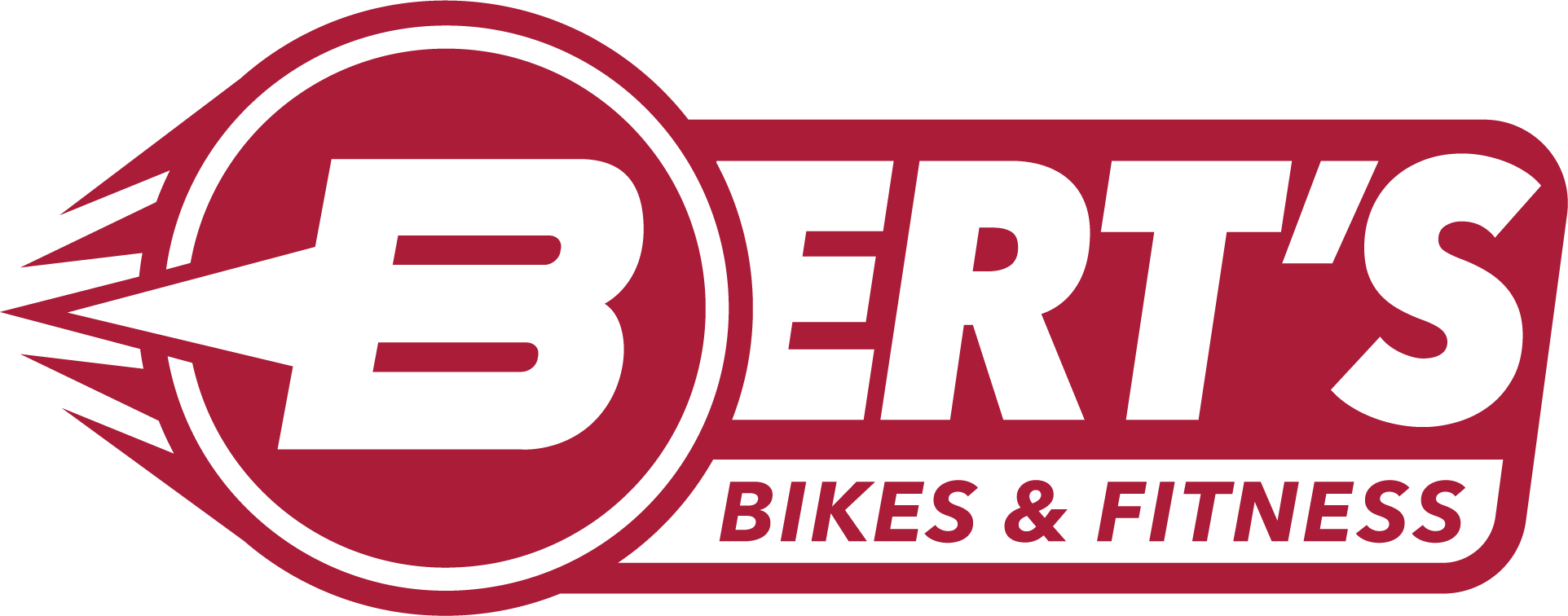
- Bikes & Fitness
- Speed Concept
Trek Speed Concept
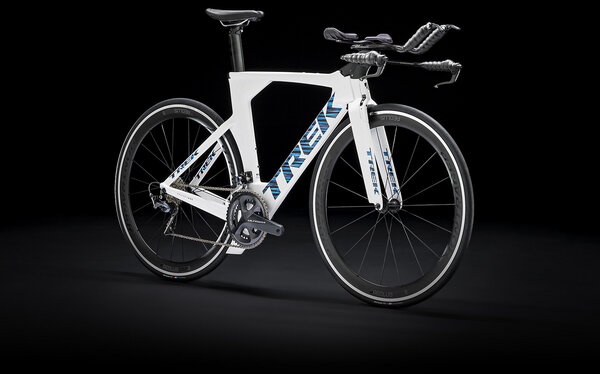
Speed Concept is a lot of things, but above all, it’s fast. It's our most aerodynamic bike, which makes it an ideal triathlon bike and a great choice for TT enthusiasts who know every second matters. Plus, it's an exceptional value: adjustability, integration, customization options, aero wheels, and an 11-speed drivetrain—all in a super aero bike built for flat-out speed. It's right for you if... You're out to win, and you're looking for the aero advantage other triathlon bikes simply can't provide. You understand fit is a crucial part of going fast, and you want a bike that's infinitely customizable to your perfect aero position. The tech you get Lightweight 500 Series OCLV Carbon frame, drag-reducing Kammtail Virtual Foil (KVF) tube shaping, full Shimano Ultegra 11-speed drivetrain with Dura-Ace bar end shifters, fully integrated handlebar and stem, Bontrager Hilo Comp triathlon-specific saddle for an aggressive and aero position, and aerodynamic Bontrager Aeolus 5 Comp TLR wheels. The final word When you ride Speed Concept, you're gonna go fast. A lightweight carbon frame, aero tube shaping, carbon wheels, and an 11-speed Shimano Ultegra drivetrain mean speed and efficiency where it counts. Triathletes, time trialists, general speed demons—this one's for you. Why you'll love it - It's a triathlon superbike that's proven to be the fastest in the wind tunnel - PRs are for breaking, and Speed Concept is the bike designed to put you closer to whatever goal you've set for yourself, whether that's a faster bike split or a new speed record - Make it yours: it's fully customizable through Project One - Speed Concept is easy to adjust and comes in an extended size range, which means every rider can find their fastest, most dialed fit - Easy build, easy travel: fast assembly makes it easier to travel to races
Geometry chart
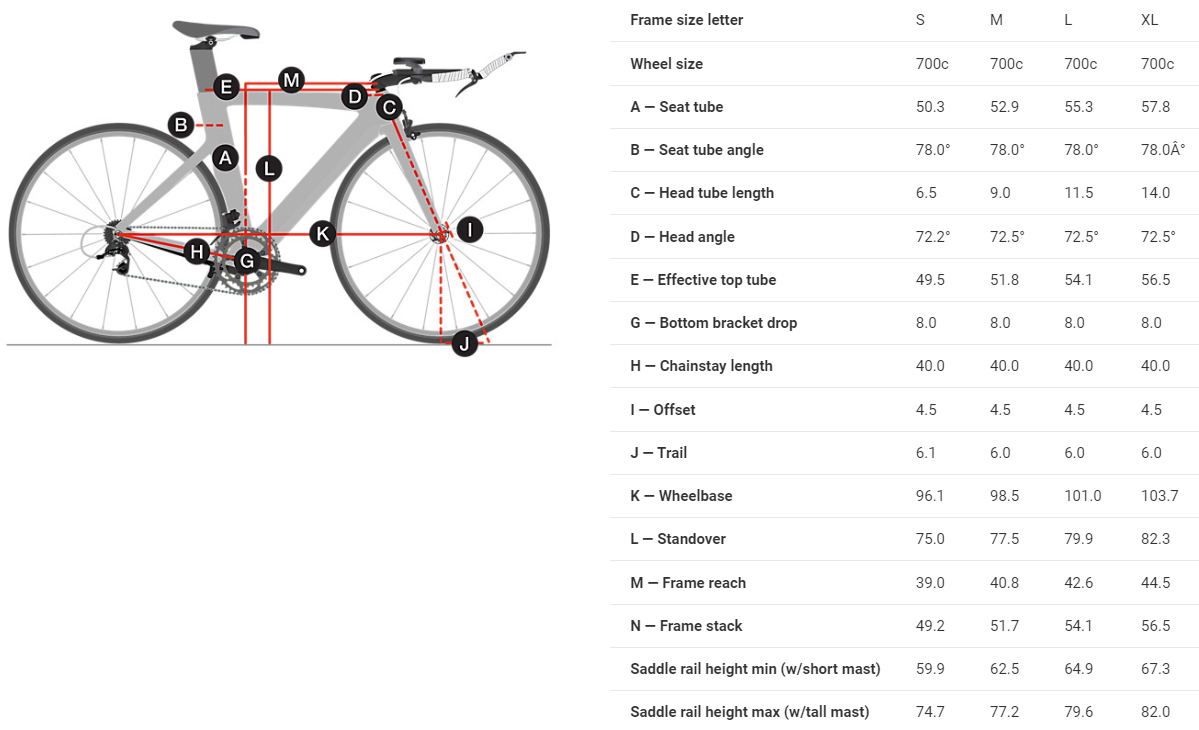
Pedals sold separately
Due to supply-chain issues, specs are subject to change without notice..
* Subject to change without notice.

- Stores Stores
- Account Account
- Subtotal : $ 0.00 Checkout Cart
- Bicycling Catalog
- Speed Concept
Trek Speed Concept

Speed Concept is a lot of things, but above all, it’s fast. It's our most aerodynamic bike, which makes it an ideal triathlon bike and a great choice for TT enthusiasts who know every second matters. Plus, it's an exceptional value: adjustability, integration, customization options, aero wheels, and an 11-speed drivetrain—all in a super aero bike built for flat-out speed. It's right for you if... You're out to win, and you're looking for the aero advantage other triathlon bikes simply can't provide. You understand fit is a crucial part of going fast, and you want a bike that's infinitely customizable to your perfect aero position. The tech you get Lightweight 500 Series OCLV Carbon frame, drag-reducing Kammtail Virtual Foil (KVF) tube shaping, full Shimano Ultegra 11-speed drivetrain with Dura-Ace bar end shifters, fully integrated handlebar and stem, Bontrager Hilo Comp triathlon-specific saddle for an aggressive and aero position, and aerodynamic Bontrager Aeolus 5 Comp TLR wheels. The final word When you ride Speed Concept, you're gonna go fast. A lightweight carbon frame, aero tube shaping, carbon wheels, and an 11-speed Shimano Ultegra drivetrain mean speed and efficiency where it counts. Triathletes, time trialists, general speed demons—this one's for you. Why you'll love it - It's a triathlon superbike that's proven to be the fastest in the wind tunnel - PRs are for breaking, and Speed Concept is the bike designed to put you closer to whatever goal you've set for yourself, whether that's a faster bike split or a new speed record - Make it yours: it's fully customizable through Project One - Speed Concept is easy to adjust and comes in an extended size range, which means every rider can find their fastest, most dialed fit - Easy build, easy travel: fast assembly makes it easier to travel to races
Geometry chart

Pedals sold separately
Due to supply-chain issues, specs are subject to change without notice..
* Subject to change without notice.

The 5 best bike travel cases for triathlon
- Written by Olivia Miller
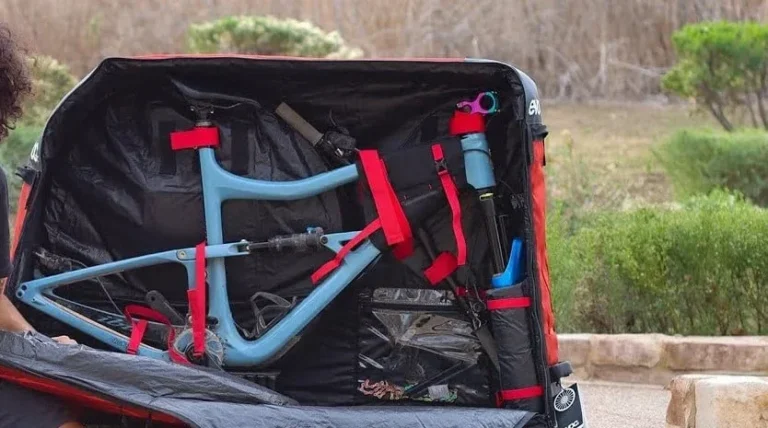
- April 1, 2024
bike travel case is an essential piece of equipment that protects your bike during transport, ensuring it arrives at your destination in the same condition it left. In this comprehensive guide, we will delve deeper into the world of bike travel cases, exploring their importance, the factors to consider when buying, how to pack your bike, and much more.
The best bike travel cases
Evoc bike travel bag xl, thule round trip transition bike case, dakine bike roller bag, orucase b2 bike travel case, b&w international bike sack – bike sack (96250/n).
I recently purchased the EVOC Bike Travel Bag XL, and I must say, it’s been a game-changer for my cycling travels. The first thing that struck me was the hybrid construction. It combines the advantages of a hard-shell case with the ease of use of a soft bag. This design is ingenious because it offers maximum protection with minimal weight, which is crucial when you’re traveling by airplane.
The bag fits my Plus Bike perfectly, but I’ve also tested it with my Cross Country and Road bikes , and they all fit just as well. This versatility is a big plus for me as I switch between different bikes depending on my destination. The bag also comes with a bike stand, clip-on wheel 2.0, and frame pad, which are all handy features that add to the overall protection and convenience.
- Buy at Amazon.com for $589.99
This case is incredibly sturdy and well-constructed, giving me peace of mind that my bike is safe during transit. The wheels on the case make it easy to maneuver, and the pull handle is a nice touch. It’s also surprisingly lightweight for its size, which is a huge plus when I’m on the go. The internal mounting system is a standout feature, it holds my bike securely and makes packing and unpacking a breeze.
- Buy at Amazon.com for $999.95
First and foremost, the Dakine Bike Roller Bag is a reliable and sturdy companion for any bike enthusiast. The bag’s design is evidently tailored for mountain bikes, but it has also proven to be effective for triathlon bikes. The 360-degree padded coverage is a standout feature, providing maximum protection with minimal weight. The bag’s construction, made of 600D water-resistant polyester, is robust and durable, ensuring it can withstand the rigors of travel and protect your precious cargo.
The bag’s size is a double-edged sword. On one hand, it’s large enough to pack extra stuff, saving money on baggage during flights. On the other hand, it can be heavy to drag through airports, especially with only two wheels. However, the bag’s rollers are smooth and make it easier to navigate through crowded spaces. The multiple grab handles also facilitate smooth transitions .
- Buy at Amazon.com for $649.00
The first thing that struck me about this case was its compact size. Despite being able to accommodate my 29 Stumpy MTB, it’s almost the size of a regular 31″ luggage, making it incredibly easy to transport. The lightweight design is a bonus, allowing me to move around without feeling weighed down.
The case is made from 1680 Denier Ballistic Nylon fabric, which is both durable and weatherproof. This gives me peace of mind knowing my bike is well-protected from the elements. The case also features a compression-molded base with aluminum rails, adding rigidity and ensuring my bike stays secure during transit. The internal pockets are a nice touch, providing ample storage for gear and small parts.
However, it’s not all sunshine and rainbows. While the case is generally easy to use, packing the bike does require an extra step compared to traditional bike cases. This isn’t a deal-breaker for me, but it’s something to keep in mind if you’re looking for a quick and easy packing process. Additionally, the case is on the pricier side, which might be a deterrent for some.
Despite these minor drawbacks, I’m thoroughly impressed with the ORUCASE B2 Bike Travel Case. It’s well-designed, practical, and most importantly, it keeps my bike safe and secure during my travels. I couldn’t ask for more.
- Buy at Amazon.com for $484.95
The B&W bag is quite large, easily accommodating my bike without having to remove the pedals or handlebars. All I had to do was remove the wheels and the bike fit perfectly . The material feels robust and durable, and I believe it will last for many trips.
However, it’s important to note that this is a soft bag, not a hard case. It’s perfect for storage or simple travel, like by car or train, but I wouldn’t recommend it for commercial airline travel unless you add some additional padding or a box for extra protection. The bag is also quite heavy and can be awkward to carry around, especially when it’s fully packed. I wish it had wheels for easier transportation.
On the positive side, the bag has wheel pockets on both sides and plenty of room for other items like helmet , tools, and even shoes. It’s a simple, no-frills bag that does its job well. However, I do think it could benefit from a few improvements like a firmer bottom, an additional small pocket on the inside, and an ID/claim holder on the outside.
In conclusion, the B&W International Bike Sack is a cost-effective solution for transporting your bike. It’s not perfect, but with a few tweaks and careful packing, it can serve you well.”
- Buy at Amazon.com for $73.99
The Importance of a Good Bike Travel Case
Firstly, let’s discuss why a bike travel case is so important. If you’re a frequent traveler, a bike travel case is not just a luxury, but a necessity. It serves as a protective shell for your bike, shielding it from potential damage during transit. This is particularly crucial when flying, as luggage can often be mishandled or tossed around.
Moreover, a good bike travel case can also provide ample storage for other cycling gear. This means you can keep all your cycling essentials in one place, making your journey more organized and hassle-free. Therefore, investing in the best bike travel case is a wise decision for any serious cyclist.
Factors to Consider When Buying a Bike Travel Case
When it comes to purchasing the best bike travel case, there are several factors you need to consider.
- Size and Weight: The size and weight of the case are vital as they directly impact its portability and the ease of handling. You want a case that can comfortably fit your bike but is also lightweight enough to carry around without much difficulty.
- Material and Durability: The case’s material and construction determine its durability and ability to withstand rough handling. Hard cases made from materials like ABS plastic offer the most protection but can be heavier and more expensive. On the other hand, soft cases or bags made from tough fabrics like nylon or polyester can be lighter and more affordable, but they may not offer the same level of protection.
- Design and Features: Look for a case with a user-friendly design and practical features. This could include things like multiple handles for easy carrying, wheels for smooth mobility, internal straps for securing the bike, and extra compartments for storing accessories.
- Price: Lastly, consider your budget. The best bike travel case for you is one that meets your needs and fits within your budget. Remember, a higher price doesn’t always guarantee better quality.
How to Pack Your Bike in a Travel Case
Packing your bike in a travel case may seem daunting, but with the right approach, it can be a straightforward process. Here’s a step-by-step guide:
- Disassemble Your Bike: Start by removing the wheels, pedals, and sometimes the handlebars, depending on the size of your case. Some cases may also require you to remove the seat post and the derailleur.
- Protect Your Bike: Wrap each part of your bike with foam padding or bubble wrap, focusing on the areas that are most prone to damage like the frame, derailleur, and brake levers.
- Pack Your Bike: Place the frame in the case first, then add the wheels and other parts. Make sure everything fits snugly and securely. Use internal straps if available to secure the bike and prevent movement during transit.
- Pack Your Accessories: If there’s room, you can also pack your helmet, shoes, and other accessories in the case. Just make sure they’re well-protected and won’t damage the bike.
In conclusion, finding the best bike travel case involves careful consideration of several factors, including size, weight, material, design, and price. With the right case, you can travel with peace of mind, knowing your bike is well-protected.
Privacy Overview
Trek Speed Concept 9 Series
Laser-focus on aerodynamic performance.
You can trust Cyclingnews Our experts spend countless hours testing cycling tech and will always share honest, unbiased advice to help you choose. Find out more about how we test.
This article originally appeared on Bikeradar
The new 9 series Trek Speed Concept is a bitching bike, in two ways. Once built, the bike flies out on the open road with stable steering, great aerodynamics and good looks. But while you (or your mechanic) are building it or working on it, you will be bitching.
Pros: Excellent aerodynamic performance: fast and stable; range of builds and paint jobs through Project One; add-ons like the trunk add real functionality and claimed aero benefit Cons: Adjusting front end for fit tweaks and/or travel is a chore; plastic frame parts feel cheap
Like most of the super bikes these days, the Trek Speed Concept is a purpose-built machine with a complete prioritization on performance above all else. Trek engineers can trot out reams of data on how the aerodynamics are superior to previous iterations, and looking at the svelte front profile and internalization of not only cables but fasteners as well, it’s not a stretch to believe that the bike performs admirably in the wind tunnel.
We tested the bike over a few hundred miles in training and in an Ironman 70.3, and came away very impressed with the bike. Our only gripes were the challenge of front-end adjustability and the relative sub-par performance of the plastic parts.
Trek sent a test bike with a Campagnolo Record EPS electronic group, but since this bike is available as Project One custom builds, we will focus on what is unique to the bike, plus the wheels.
To tweak the original Speed Concept, Trek engineers studied real-world wind conditions on Ironman courses, and settled on optimizing the bike for yaw angles between zero and 12.5 degrees. (They found 3-5 degree average yaw in Arizona, up to a 13 degree average yaw in the notoriously windy Kona worlds course.)
By slimming the front profile and tweaking the Kamm tail tubing, the 2014 version is substantially faster and lighter than its predecessor, Trek claims. For our purposes, we were only going on feel, not wind tunnel data, and in our experience, the bike handled very well in all wind conditions. With a head tube angle of 72.5 degrees on the three larger sizes, and a seat tube angle of 80 degrees across all sizes, the Speed Concept was never nervous or twitchy, even with the 90mm-deep Aeolus 9 D3 wheels in blustery sidewinds. For sure, you can feel side pressure from the wind, but the handling is always predicable and manageable. We were comfortable riding in the aero extensions through fast corners and down windswept hills.
Bottom bracket area stiffness isn't so much of a concern on such a bike, but the bike does accelerate with some snap, perhaps due to the relatively short but robust chainstays, enormous bottom bracket area and huge down tube. The low bottom bracket (8cm drop) contributes to stability.
Comfort on the frame is good. We swapped out the stock saddle for a firmer option, and were still comfortable for two- and three-hour efforts on the bike.
Total bike weight for our Large sample was 19.18lb. While Trek declined to quote a frame weight, its engineers say the frameset, cockpit setup, headset, BB and small frame parts come out to 1,874g, which they claim is less than comparable measurements on a Cannondale SliceRS, a Specialized Shiv Tri or a Cervélo P5-6.
Modular front end: For engineers, aerodynamics trumped convenience
Granted, this bike is way out on the pointy end of aero performance, and machines with such low-drag front ends have until recently been custom creations for the world's best pros. So we appreciate the challenge in building a stock bike that has both a superior aero shape and the ability to adjust to fit a range of riders. Trek's solution is a modular front end, with a collection of stem heights/lengths and riser blocks. From there, one of four monocoque extension bars mounts atop the riser block of choice, and the pads are mounted via a collection of bolts and mount options. Should you have your measurements dialed ahead of time, Trek provides a worksheet that will get your fit close, specifying which stem and riser block to use.
Trek has improved the cockpit options somewhat for 2014. You can tilt the extensions with the adjustment of three bolts, which is nice. But the base bar remains dead level. This is best for aerodynamics, of course, but we would have preferred a slight upward angle on the outer handles for a bit more grip security.
And while there are four styles of extensions to choose from — S-bend, straight, ergo and short ergo — none allow width or angle adjustment as they are one-piece designs. Whether it's another price paid for aerodynamics or perhaps just simplicity in construction, it's certainly something to keep in mind. We used the ergo bar and found that while the bend angle was comfortable, we missed the rotational adjustment you can get on most aftermarket bars.
Knee clearance when out of the saddle was not an issue with the bar - as it sometimes is with TT/tri machines with large aero basebars.
Other components: Seatpost is super user friendly, but plastic parts aren’t the same caliber as the rest of the bike
The Speed Concept's spring-loaded seatpost clamp is a thing of beauty. It's just... easy. One 5mm bolt at the front for final tightness combines with a finger-operated dial at the rear for angle adjustment. A spring pushes the top plate up when loosening the bolts, and unlike many seatposts, there aren't loose parts to fall out when you swap saddles. If only all seatposts were this easy. Kudos, Trek.
The plastic parts are a bit disappointing. The front brake fairing - while it does offer little holes for pad holder adjustment on either side - did not sit perfectly flush with the fork on our test bike. For a bike of this cost, that's not cool. Also, while we love the functionality and general design of the Draft Box, the lid attachment feels chintzy, relying on the elasticity of plastic latches to lock it into place. The one time we crammed the Box to capacity, it popped open when we hit hard bumps like railroad tracks. When not jam-packed, the lid stays shut, but the connection mechanism definitely has room for improvement.
Trek sells the Speed Concept as a frameset and in a variety of bike builds. While we won't go into the Campagnolo EPS Record group here, it is worth noting that the Bontrager Aelous 9 D3 carbon clincher wheels were flawless throughout the testing. Having carbon clinchers on this bike makes good sense to us as there's no reason you can't race and train on the same wheelset. Yes, your buddies and perhaps total strangers will make fun of you for training on super-deep carbon hoops, but this is much better than training on shallow wheels then jumping on deep wheels for race day and freaking out every time the wind blows because you are unaccustomed to the feel. And besides, if you're going to spend this much on a bike, why not rock the hot wheels every day?
Bottom line: The 2014 Trek Speed Concept is a highly specialized machine within an already specialized category of bicycles. Working on it is not easy, but it does seem to live up to Trek's promises of a very fast, very functional machine for solo efforts — and with custom paint options, to boot.

Thank you for reading 5 articles in the past 30 days*
Join now for unlimited access
Enjoy your first month for just £1 / $1 / €1
*Read any 5 articles for free in each 30-day period, this automatically resets
After your trial you will be billed £4.99 $7.99 €5.99 per month, cancel anytime. Or sign up for one year for just £49 $79 €59
Try your first month for just £1 / $1 / €1
After a year of waxing my chains here’s why I’m going back to oil
Campaign across the UK cycling industry aims to increase e-bike battery safety
Renewi Tour 2024 route
Most Popular
Please visit our Light Rail Rehab page for more information on the upcoming August 29-September 2 & September 18-22 bus bridge.
Your feedback matters! Take our onboard survey starting September 3 and help shape the future of VTA
- Speed Limits
While the best way to slow vehicle speeds is through physical design of the street, setting context-appropriate speeds and enforcing speed limits can have some impact on reducing speeds.
Reevaluate assumptions about speed limits. A research synthesis conducted in 2020 by the University of California’s Institute for Transportation Studies found that reducing posted speed limits also reduces drivers’ operating speeds and improves safety across most road environments. This synthesis also found that recent studies indicate that there is not strong evidence to support the claim that using the 85th percentile speed resulted in the lowest crash rate.
- Set speed limits considering context. The Department of Motor Vehicles states that regardless of the posted speed limit, speed should depend on various conditions, including the presence of bicyclists or pedestrians on or crossing the roadway. Agencies conduct engineering and traffic studies (ET&S) to establish speed limits. The ET&S considers the prevailing speed of traffic, history of crashes, and pedestrian and bicyclist safety. The most widely accepted method of determining the posted speed is to set it at the speed at or below which 85 percent of the traffic is moving. However, special circumstances as determined by a traffic engineering study can warrant the lowering of speed limits such as unusual geometry, school zones, restricted sight distance, unsafe conditions, or significant pedestrian activity.
- Set slower speeds in school zones. In school zones, business districts, and residential areas, the Prima Facie speed limit is 25 mph, meaning drivers must drive at 25 mph or less even if speed limit signs are not posted. If lower speeds are marked, those must be followed. For example, California law permits a 15 mph speed limit adjacent to schools.
- Review and reset speed limits after installing roadway modifications that calm traffic. Installing traffic calming features along a roadway can reduce vehicle speeds and then warrant a speed limit reduction based on the current law.
- Enforce posted speeds using presence of law enforcement, portable, and permanent speed feedback signs.
- Stay abreast of changing guidance on setting speed limits. In California, the primary way speed limits are set is by setting the speed within 5 mph of the 85th percentile speed–the speed at which 85 percent of vehicles are traveling at or below. This methodology was developed decades ago for vehicles on rural roadways and does not consider urban roadways where people are walking and biking. In September 2021, the California legislature passed AB 43 that permits local jurisdictions to lower speed limits on certain streets. Under the law, local jurisdictions may set lower speed limits on streets and state highways that pass through business and residential areas and or that are designated “safety corridors” without following the 85th percentile law. The law is being phased into implementation, with full implementation no later than June 2024. This law was based on work conducted by the Zero Traffic Fatalities Task Force established by the California Secretary of Transportation in 2008.
- Development and Built Form Home Page
- Sites and Buildings
- Building Design
- Development Projects
- Case Studies
- Street Design - Home Page
- Streets as Places
- Connectivity
- Pedestrian Environment
- Intersections
- Transit Streets
- Mixed Use Streets
- Commercial Street
- Multiway Boulevard Commercial Street
- Main Street
- Business Park Street
- Residential
- Shared Street | Woonerf
- Parking Design - Home Page
- Safety and Pedestrian Circulation
- Visual Buffers and Landscaping
- Energy Efficiency and Environmental Quality
- Preferential Parking
- On-Street Parking Design
- Bicycle and Micromobility Device Parking Design
- Parking Structure Design
- Transportation and Public Life - Home Page
- Urban Pattern
- Open Space Structure
- Streetscape Design
- Open Space Design
- Transit Waiting Area Design
- Crime Prevention Through Environmental Design
- Create Community Identity
- Community Wellbeing
- The Role of Local Government & Transit First Policies - Home Page
- Transit-First Policy
- Guiding Principles of Land Use - Home Page
- Build Effective Partnerships
- Support Transit Service and Increase Ridership
- Support Equitable Transit Oriented Communities
- Prioritize Multimodal Sustainable Travel
- Flexible Zoning Strategies - Home Page
- Mixed Use Zones
- Smaller Zones for Individual Uses
- Transit Zones
- Community Centered Development Standards
- Accessory and Attached Dwelling Unit Incentives
- Master Plans
- Unified Development Ordinance
- Overlay Zones
- Performance Zoning
- Street Design Implementation - Home Page
- Interdisciplinary Approach
- Functional Classifications
- Quick Build Projects
- Tort Liability
- Multi-Modal Perspective at the Agency Level
- Revising Transportation Analysis Practices - Home Page
- Modernize Transportation Analysis Policies
- Performance Standards for Active Modes
- Update Level of Service (LOS) Analysis Practices
- Vehicle Miles Traveled (VMT) and Multimodal Improvements
- Consider Broader Mitigation Frameworks
- Develop a Program Environmental Impact Report (EIR)
- Transportation Demand Management - Home Page
- Changing the Cost of Commuting
- Helping Communities Leave Their Cars at Home
- Transportation Demand Management and the Development Process
- Transportation Management Associations
- Sustainable Model Education, Infrastructure and Accessibility
- Transit and Transit Oriented Development
- Legal Considerations
- Rethinking Vehicle Parking Requirements - Home Page
- Flexible Vehicle Parking Standards
- In-Lieu Fees
- "Unbundle" Parking Costs
- Bicycle and Micromobility Devices Parking Standards
- On-Street Parking Policy
- Loading Zones
- Parking Management - Home Page
- Shared Vehicle Parking
- Data, Technology, and Pricing to Manage Parking
- Vehicle Parking Duration Limits
- Permit Parking
- Curb Management
- Area Parking Management Plans
- Pay-Per-Use Automobile Services
- Reduce Parking Demand
- Best Practices to Attract Successful Developers - Home Page
- Joint Development
- Casting a Wide Net
- Enumerated Components of Mixed-Use
- Innovative Market Analyses
- Apportioned and Mitigated Risk
- Value Capture Baseline
- Special Taxes and Assessments
- Equitable Development Incentives
- Community Collaboration
- Environmental Regulations
- Clarifying Design Expectations - Home Page
- Clarify the Vision Early
- Develop a Design Review Process
- Pursue Catalytic Projects
- Integrating Retail into TOD - Home Page
- Retail Concept and Tenanting Plan
- Retail Vacancies
- Financial Incentives for Retail Development
- Local Retail
- Siting Retail
- Ground Floor Activation
- Experiential Retail
- Flexibility in Retail Uses
- Community Planning for Rail Transit - Home Page
- The Planning Process
- Role of Local Jurisdictions
- Transit Planning Best Practices
- Improving Station Area Environments
- Station Area Design
- CDT Bibliography Homepage
- CDT Related Documents Home Page
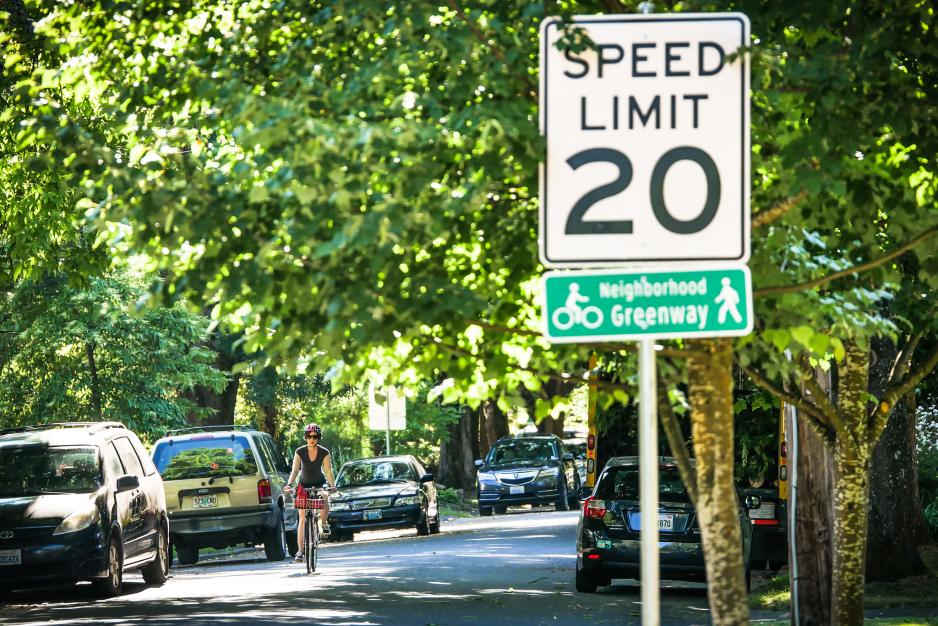

COMMENTS
Dec 2, 19 6:06. Post #16 of 29 (8011 views) tessar wrote: I don't know if it's the best, but I recently got a Scicon AeroComfort Tri 3.0 for my bike, which happens to be a Trek Speed Concept size L, maxed out on reach. While I still remove the extensions just to be safe, they easily fit in the case.
Our fit system also makes Speed Concept very easy to pack. If your travel case allows for it, packing can be as simple as removing the base bars from the frame by loosening three bolts. For tighter-fitting cases, you can remove an additional four bolts to take the towers off the base bar. Either way, your fit is perfectly preserved, and it only ...
Size L 2023 Speed Concept. Need to remove pedals. Oddly enough, I also need to remove the cockpit. It's 4 screws/washers. I leave the Di2 wires attached and take them against the base bar with foam padding so they don't move around and scratch stuff during travel. It's still way more convenient than any other option.
Community Workouts/Challenges. 100/100 Run Challenge
Plus we were able to fit so much gear and clothes around the bike, we were able to take one less suit case. For taking a SC in this bag it's pretty easy. Of course wheels off and in the supplied bag. Seat post off. The base bar is detached by three bolts. Then use lots of foam and zip tie those to the frame.
Our fit system also makes Speed Concept very easy to pack. If your travel case allows for it, packing can be as simple as removing the base bars from the frame by loosening three bolts. For tighter-fitting cases, you can remove an additional four bolts to take the towers off the base bar. Either way, your fit is perfectly preserved and it only ...
Trek claims the Speed Concept is a huge 30% more compliant, which should leave you less fatigued for the run. This top-end version costs a huge £12,100, so all mod cons are included, such as a power meter with the SRAM electronic groupset. The 'cheapest' Speed Concept with SRAM Rival is £8,100, which still gets you largely the same ...
Aerodynamic triathlon bike design often involves big sections of carbon fiber for the frame, deep-section wheels, aero seat posts—in a word, stiff. To give the Speed Concept a big leap forward in rider comfort, Trek added their proven IsoSpeed technology to the seat tube. This claims to have improved rider comfort by a whopping 30-40%.
The latest version of Trek's Speed Concept goes from a monopost aerobar riser to a dual post version. The new Speed Concept also has the fascinating IsoSpeed suspension system that's meant to remove vibrations from the road into the rider—reducing fatigue for the bike and run. Trek has also improved aerodynamics by a claimed 16 minutes ...
Speed Concept is a triathlon bike engineered to be fastest in its class. But it's not all aerodynamics and ultra-light carbon. It's also seamlessly designed hydration and fueling systems that boost your energy post-swim, keep you strong as you cycle, and set you up for your best run ever. We put our best into this bike, and you've put ...
The 2021 bike, featuring disc brakes, the first Speed Concept update since 2014, remains true to its heritage. Online triathlon magazine with product reviews, a bike fit guide, training tips, and several regular columnists. ... Now, if you do travel with this bike, in a bike case, on a plane, I have a recommendation. Remember, this is an ...
The SLR 7 model we reviewed comes with Ultegra Di2 components, the impressive Speed Concept integrated cockpit and Bontrager Aeolus Pro 51 tubeless ready wheels. (Click on the images above for more detail.) We did feel a bit of a push at the front end in strong side winds, so if you're lighter and heading to a race like Kona or Lanzarote, you ...
Though we tested the SLR 7 Ultegra 12-speed build of this new Gen 3 Speed Concept, the features on each of the four flavors (SLR 9, 9 eTap, 7eTap, and 7) are similar—save for wheels, drivetrain, and a few other bits like saddles. The frames/forks/bars are the same. According to Trek, the big news about this redesign is the fact that the new ...
Your estimate (10 or 15 Watt for just 1 kph more speed) is probably OK, a bit conservative even: Let's suppose you need around 250 Watt for 38 kph (source: Zwift Insider). And let's ignore rolling resistance for this back of the envelope calculation. In that case you would need (39/38)^3 * 250 = 270 Watt for 39 kph. 20 Watt or 8% more.
I got a med-far stem so am aware that this in combination with XL frame size isn't that common and won't easily fit in any travel case, hard or soft. Really hoping the Evoc road bike bag pro will suit my bike better but would like to hear opinions first before purchasing.
Speed Concept is a lot of things, but above all, it's fast. ... - Easy build, easy travel: fast assembly makes it easier to travel to races Geometry chart Sizing ... Bontrager R2 Hard-Case Lite, 700c x 25 Crankset Shimano Ultegra Chainrings 50/34T (compact) Bottom Bracket BB90 Chain
Speed Concept is a lot of things, but above all, it's fast. ... - Easy build, easy travel: fast assembly makes it easier to travel to races Geometry chart Sizing ... Bontrager R2 Hard-Case Lite, 700c x 25 Crankset Shimano Ultegra Chainrings 50/34T (compact) Bottom Bracket BB90 Chain
The 360-degree padded coverage is a standout feature, providing maximum protection with minimal weight. The bag's construction, made of 600D water-resistant polyester, is robust and durable, ensuring it can withstand the rigors of travel and protect your precious cargo. The bag's size is a double-edged sword.
Trek Speed Concept 9 Series: Trek's latest TT/Tri iteration shaves nearly a pound off the 2013 model ... Cons: Adjusting front end for fit tweaks and/or travel is a chore; plastic frame parts feel ...
CALIFORNIA HIGH-SPEED RAIL. STATEWIDE SYSTEM. In preparation for the procurement of the initial trainsets, California High-Speed Rail is developing concepts for the layout and interiors of the cars that will shape an iconic design and set new standards for rail travel on the first true American high-speed train service. Sacramento. San Francisco.
Set slower speeds in school zones. In school zones, business districts, and residential areas, the Prima Facie speed limit is 25 mph, meaning drivers must drive at 25 mph or less even if speed limit signs are not posted. If lower speeds are marked, those must be followed. For example, California law permits a 15 mph speed limit adjacent to schools.
Travel Forum ; Airlines ; Travelers' Choice ; Help Center ; Just ok - K1 Speed Santa Clara. United States ; ... 01/26/2020 We brought 5 boys to K1 Speed in Santa Clara on a Saturday morning. We got there around 10:30 and there was no parking. ... Every 11 year old girl should be ready to drive an F1 race car in case of a zombie apocalypse. So ...
IPTV architecture reduces travel expenses, improves employee communication, and uses WAN to transport video efficiently. Cisco® IT Case Study / WAN / IPTV: This case study describes Cisco IT's internal deployment of the Cisco IPTV® solution within the Cisco global network, a leading-edge enterprise environment that is one of the